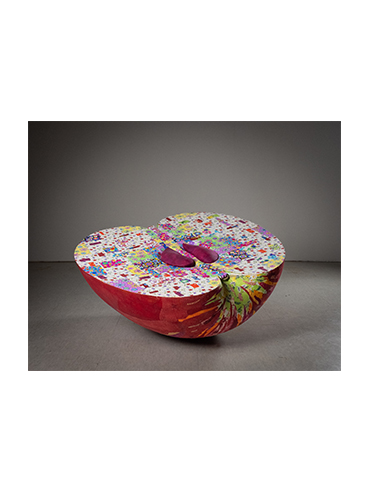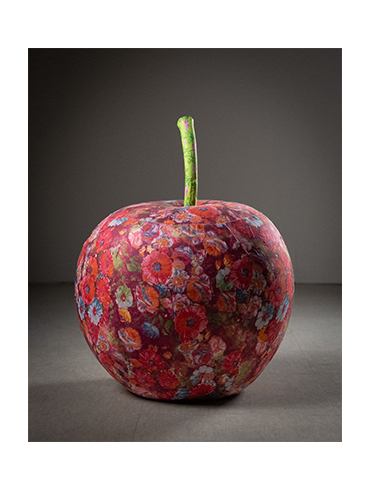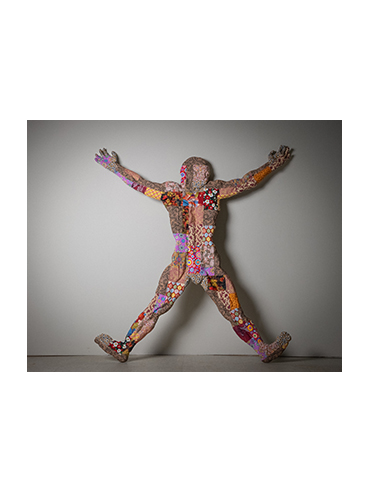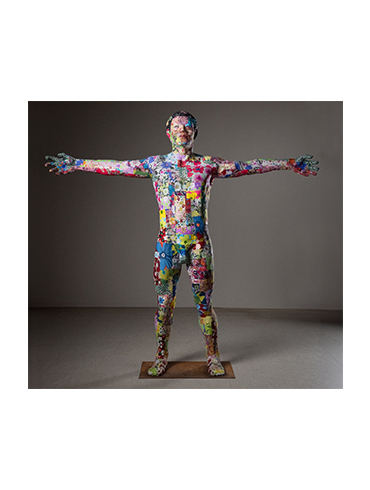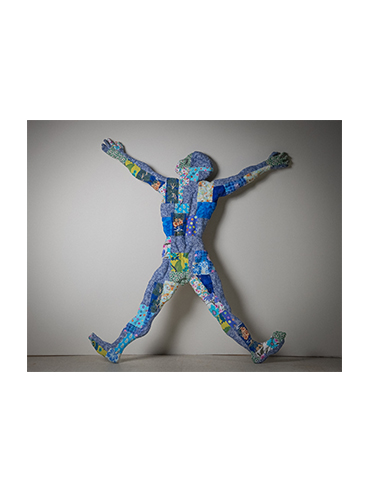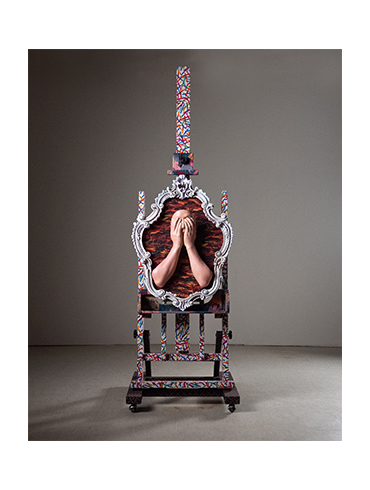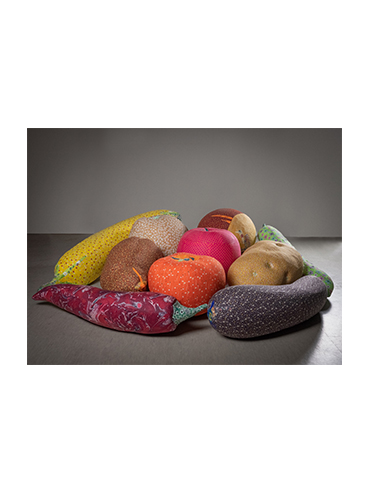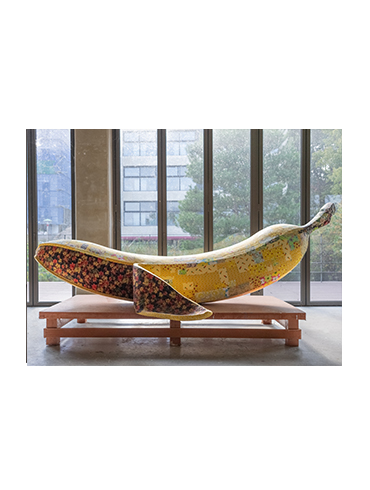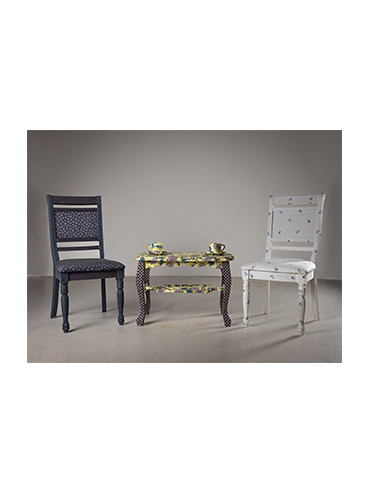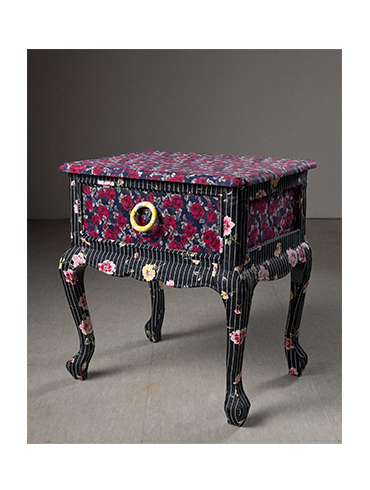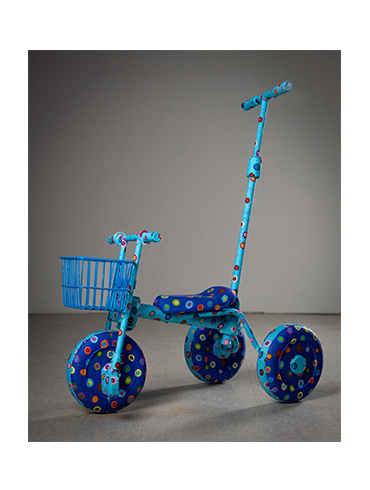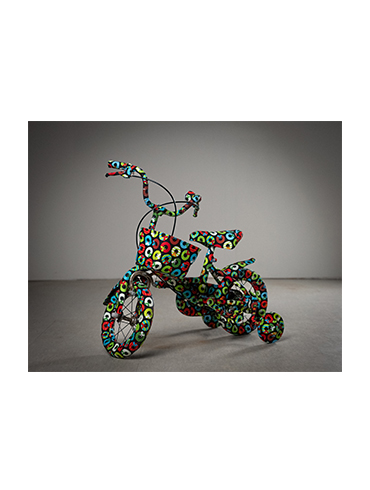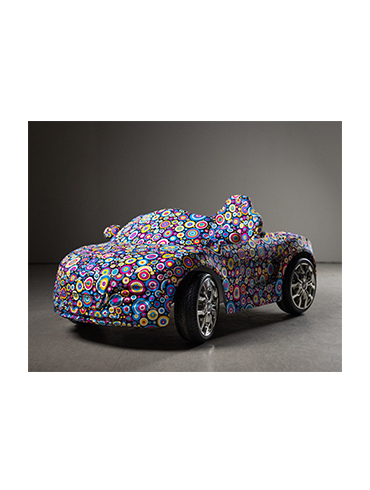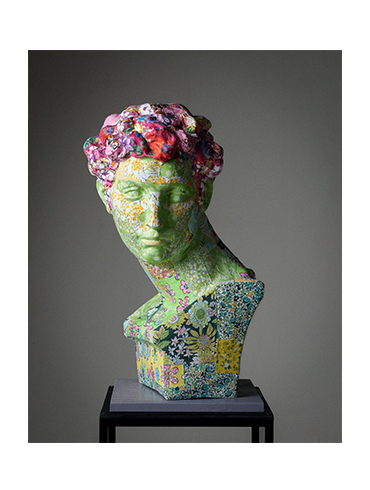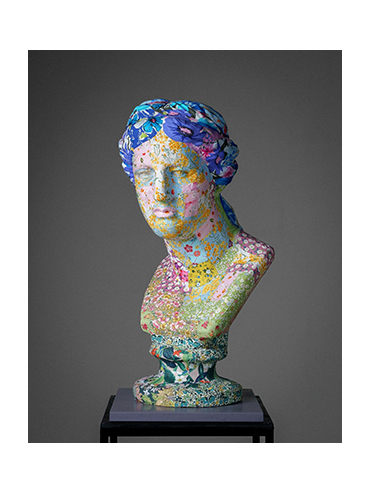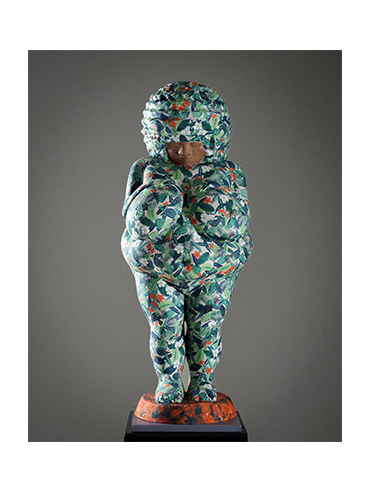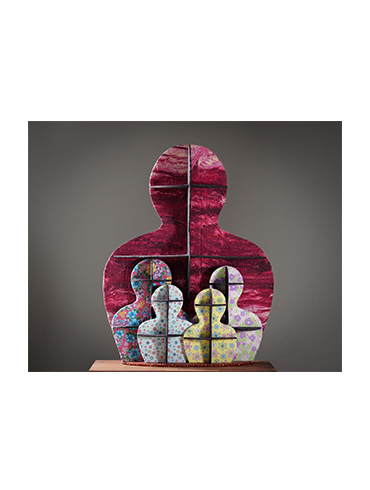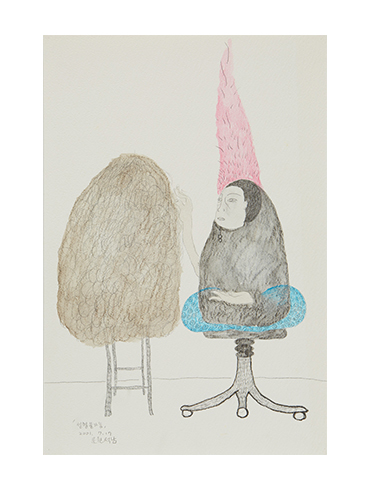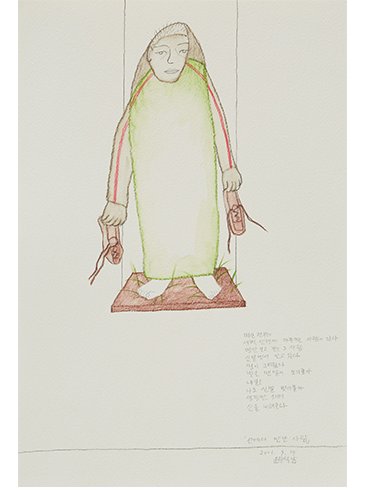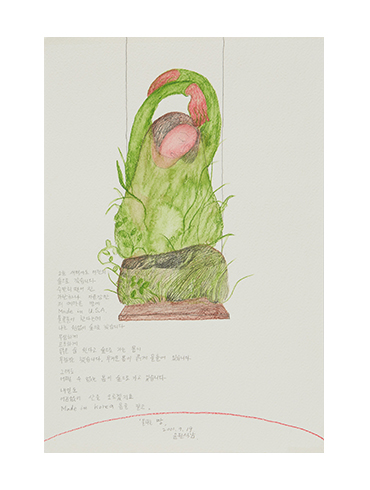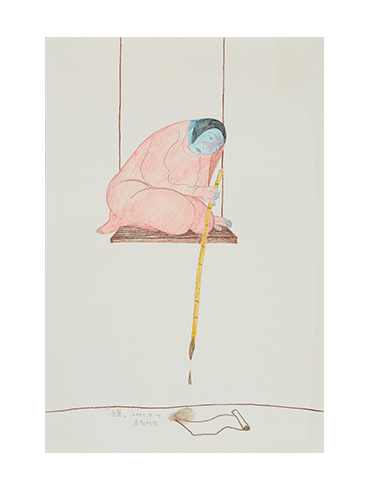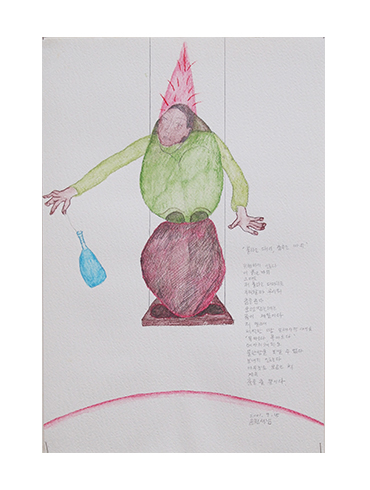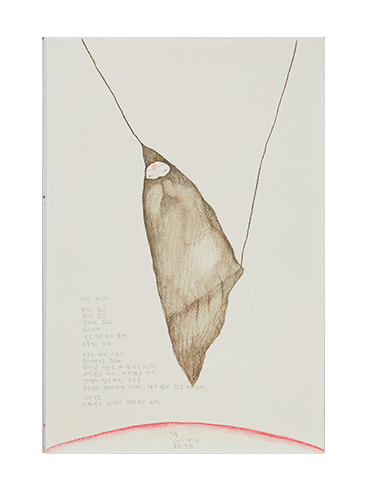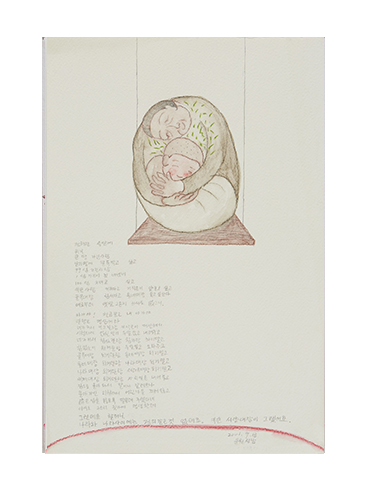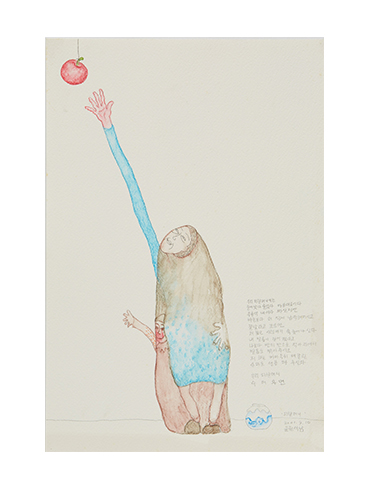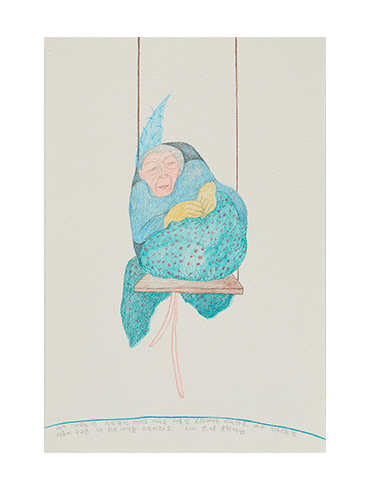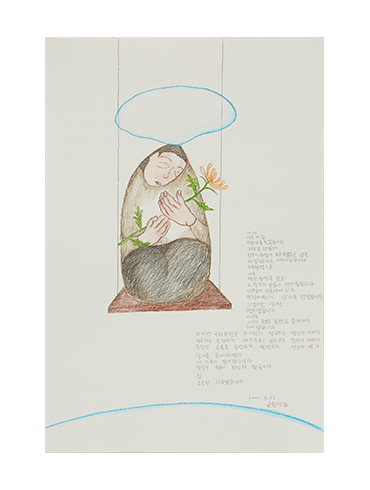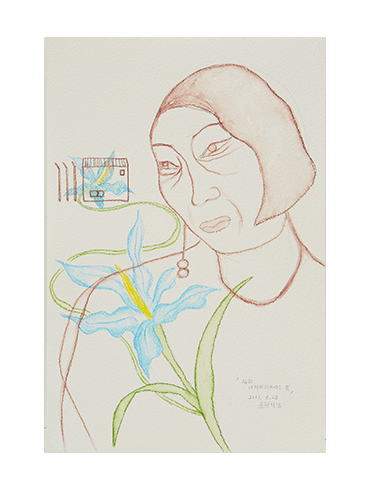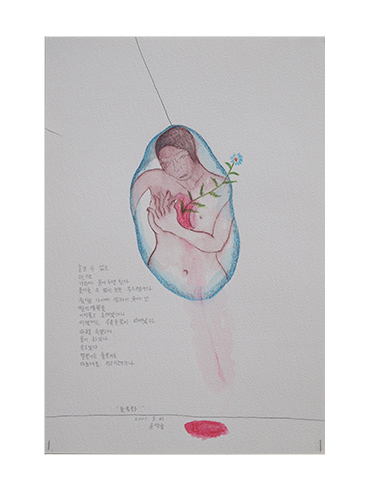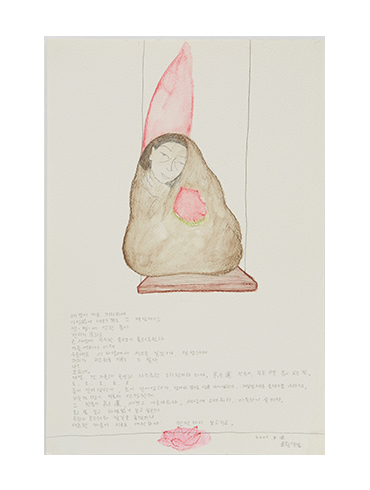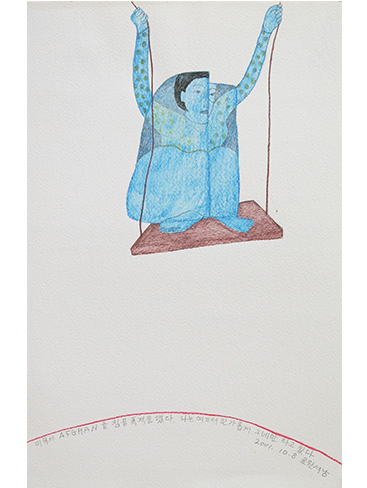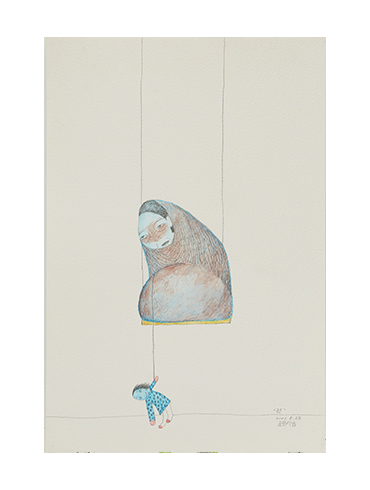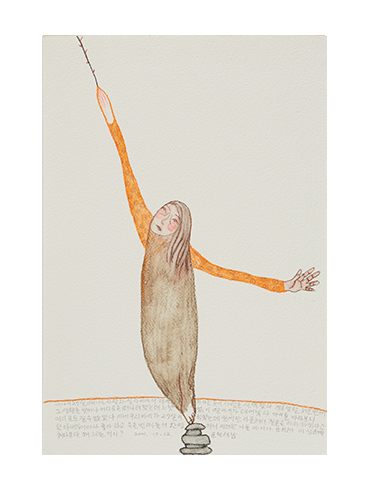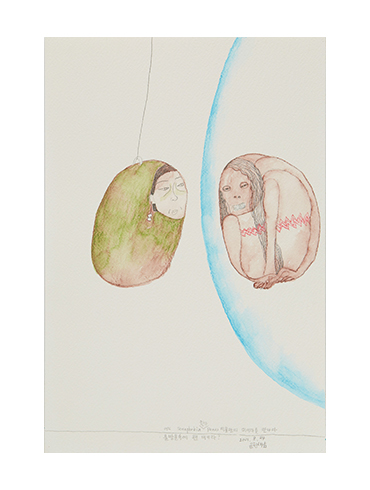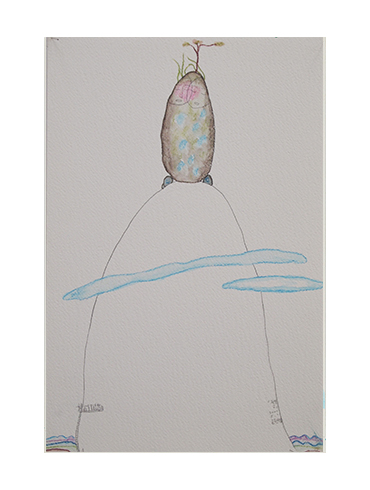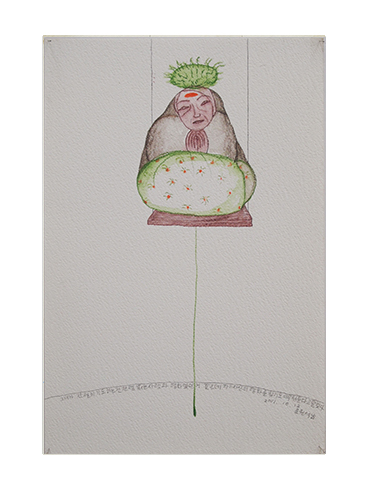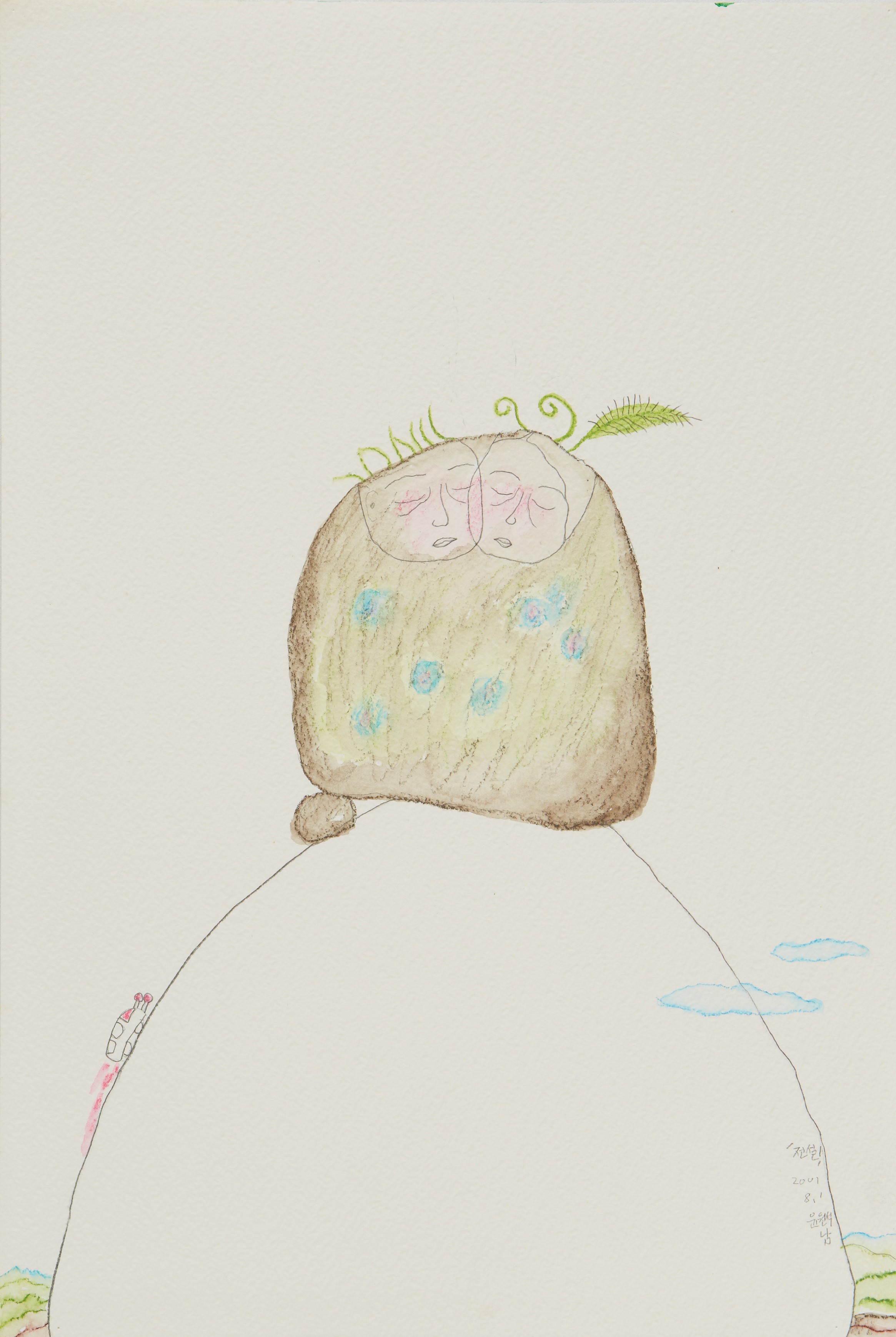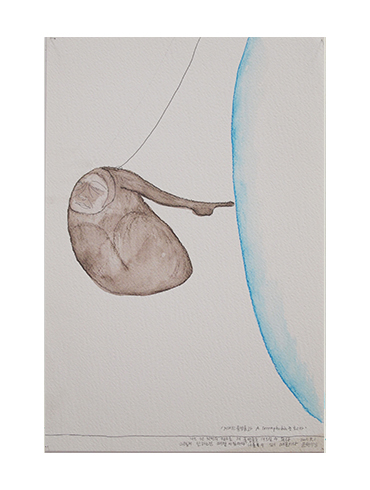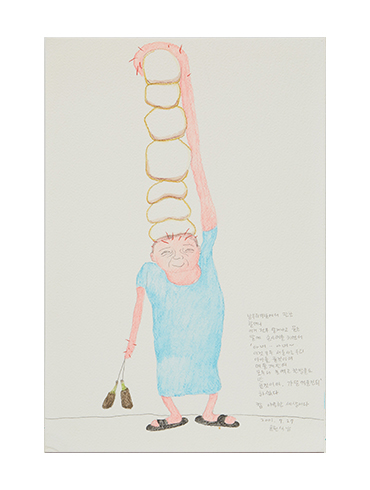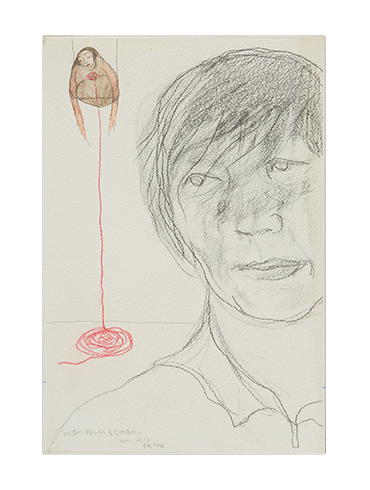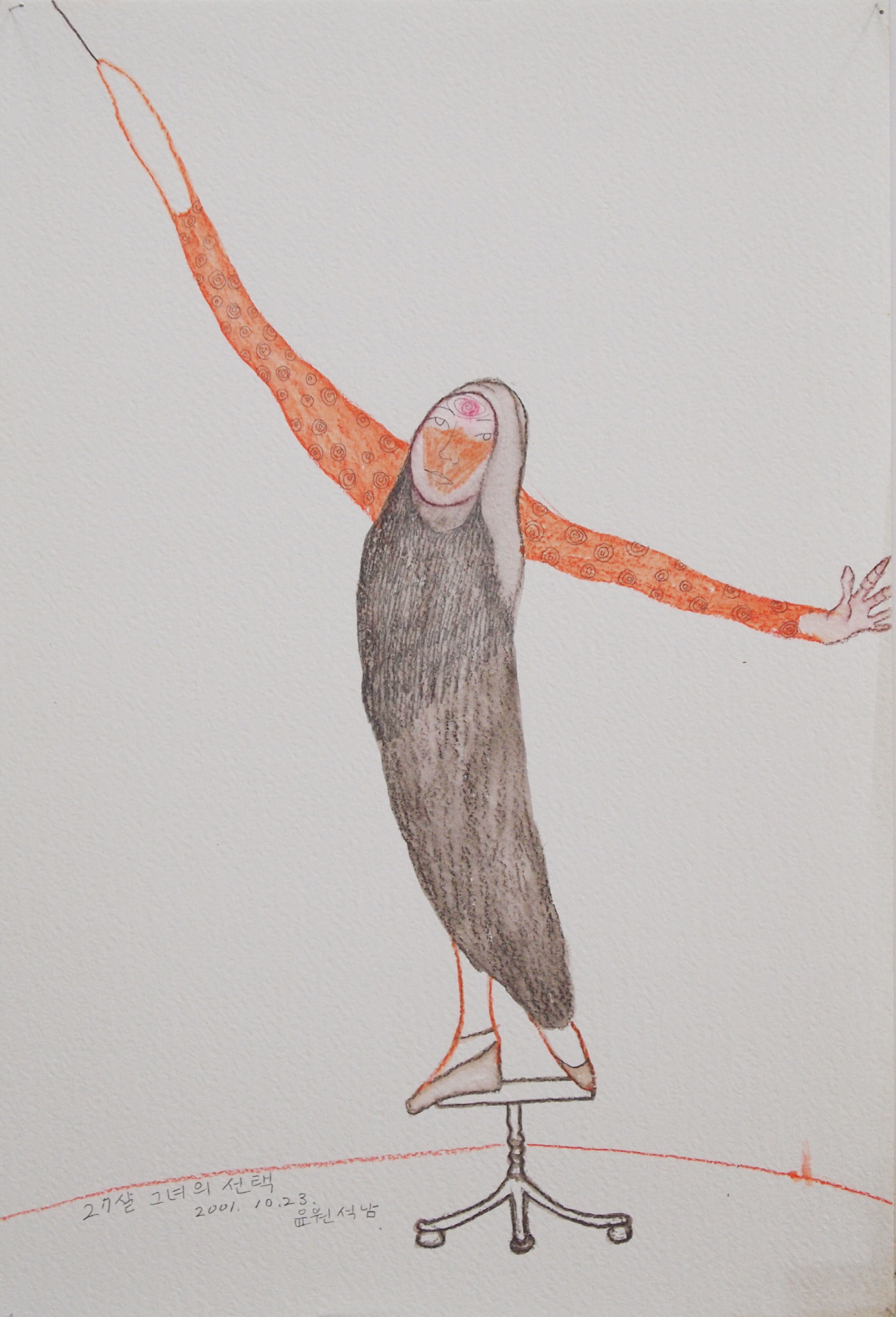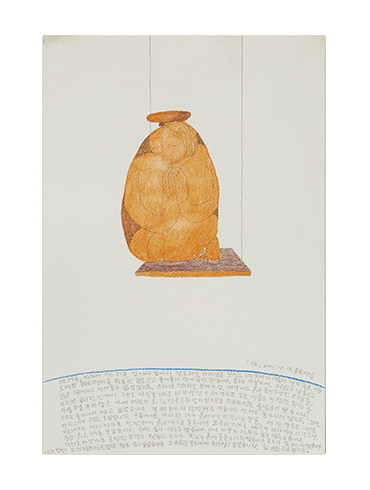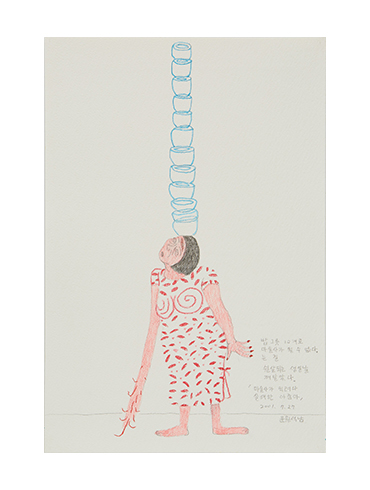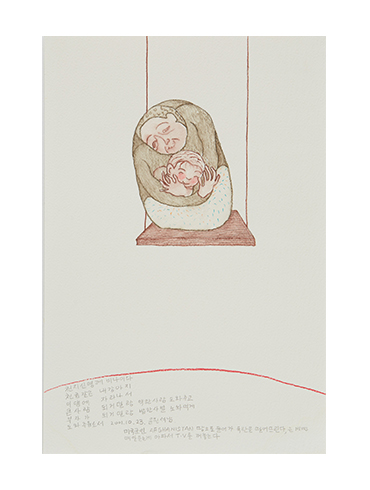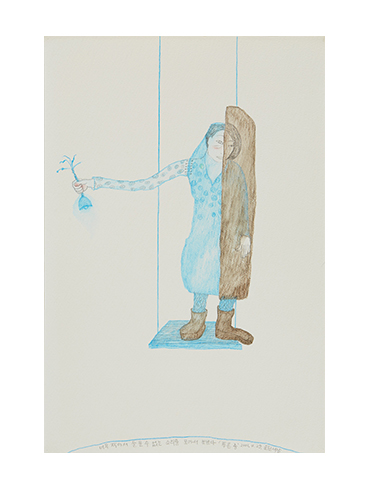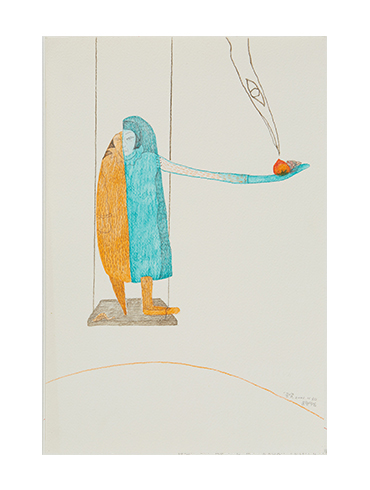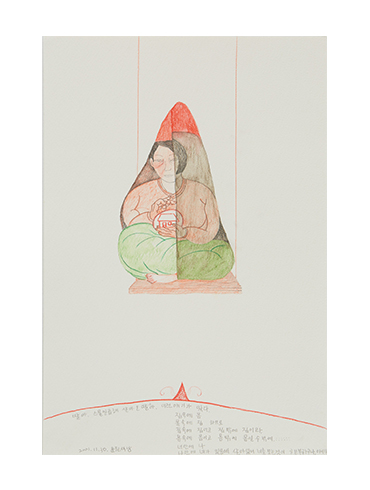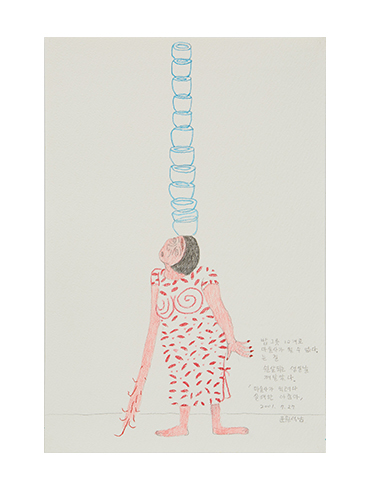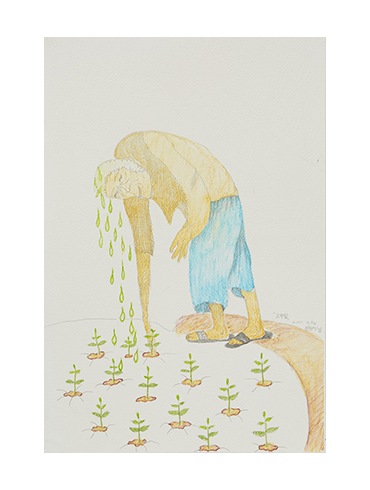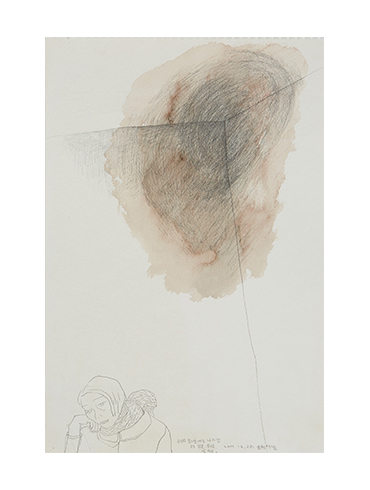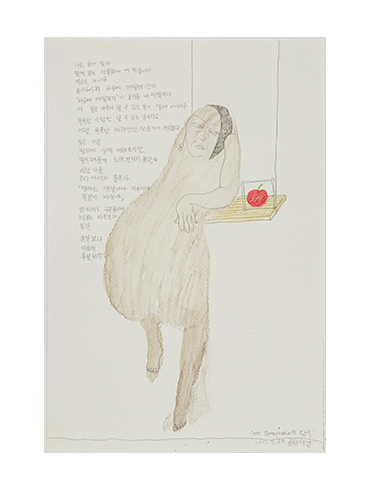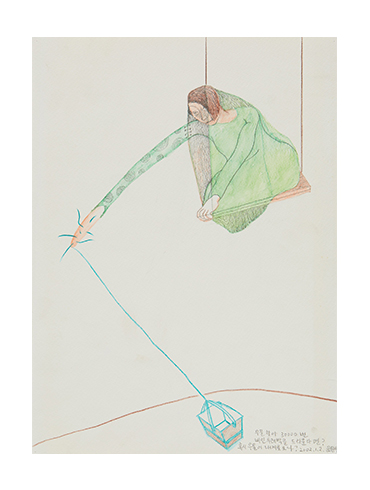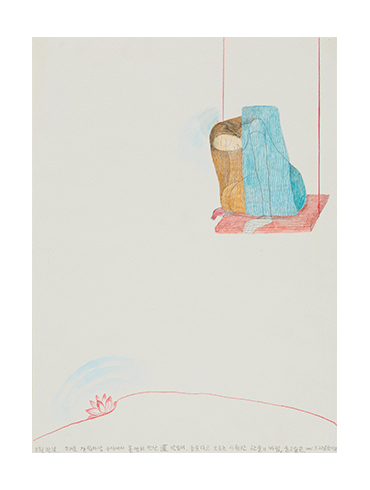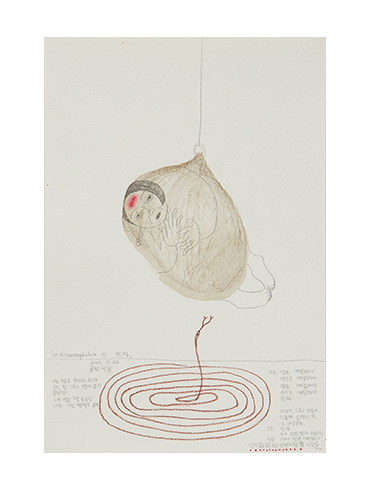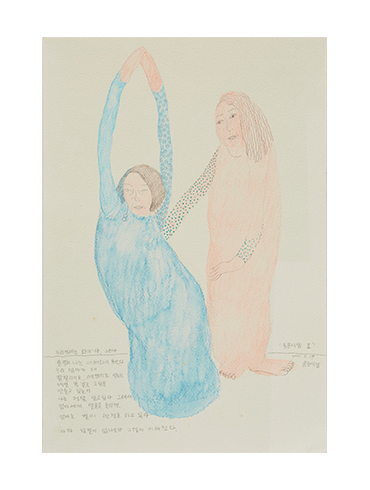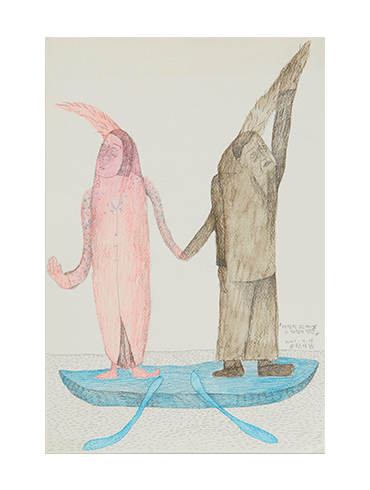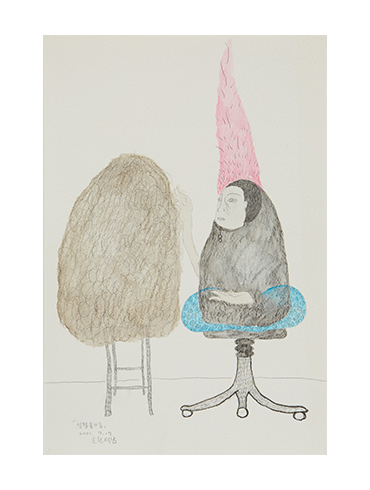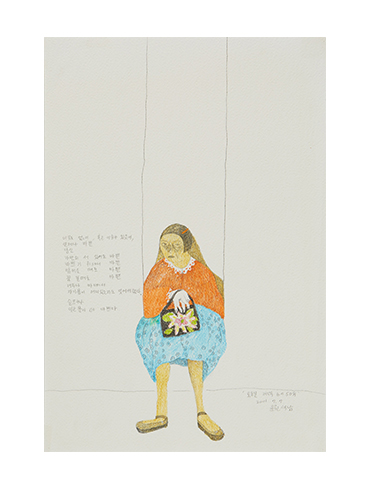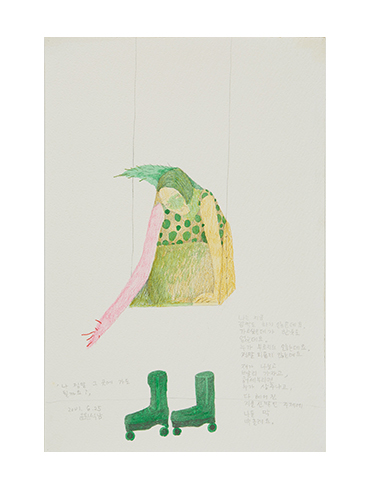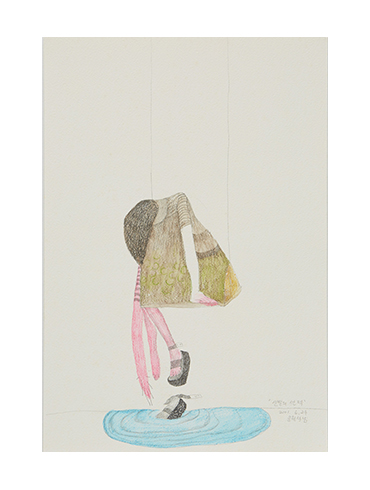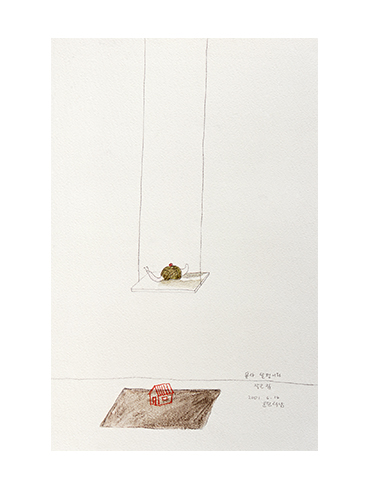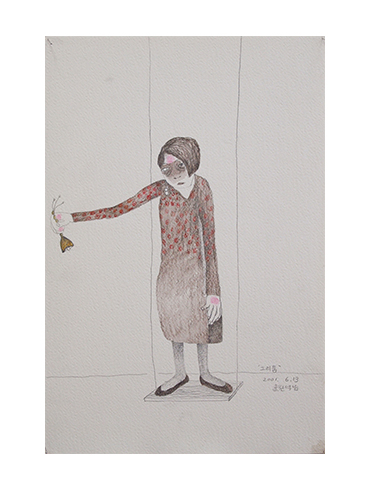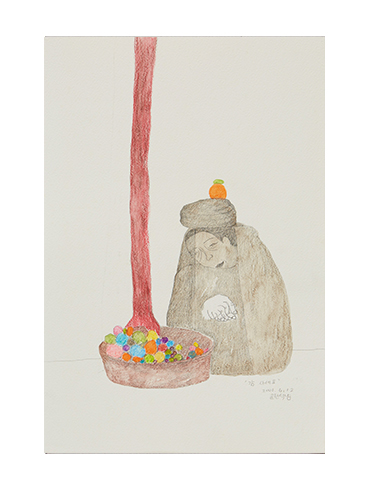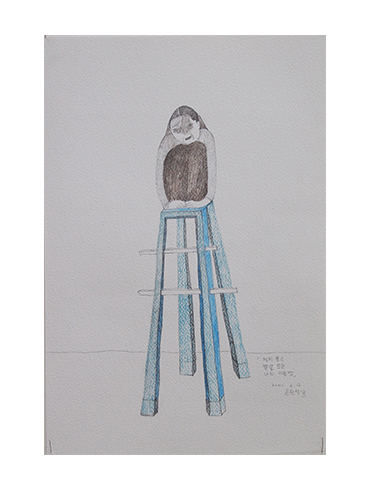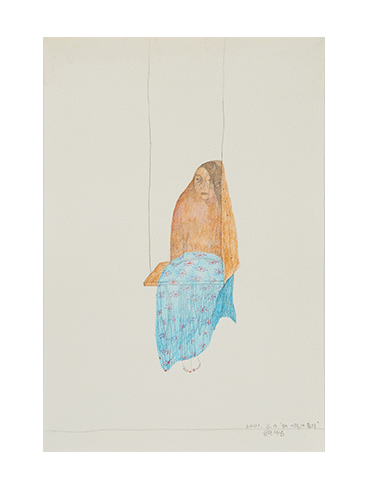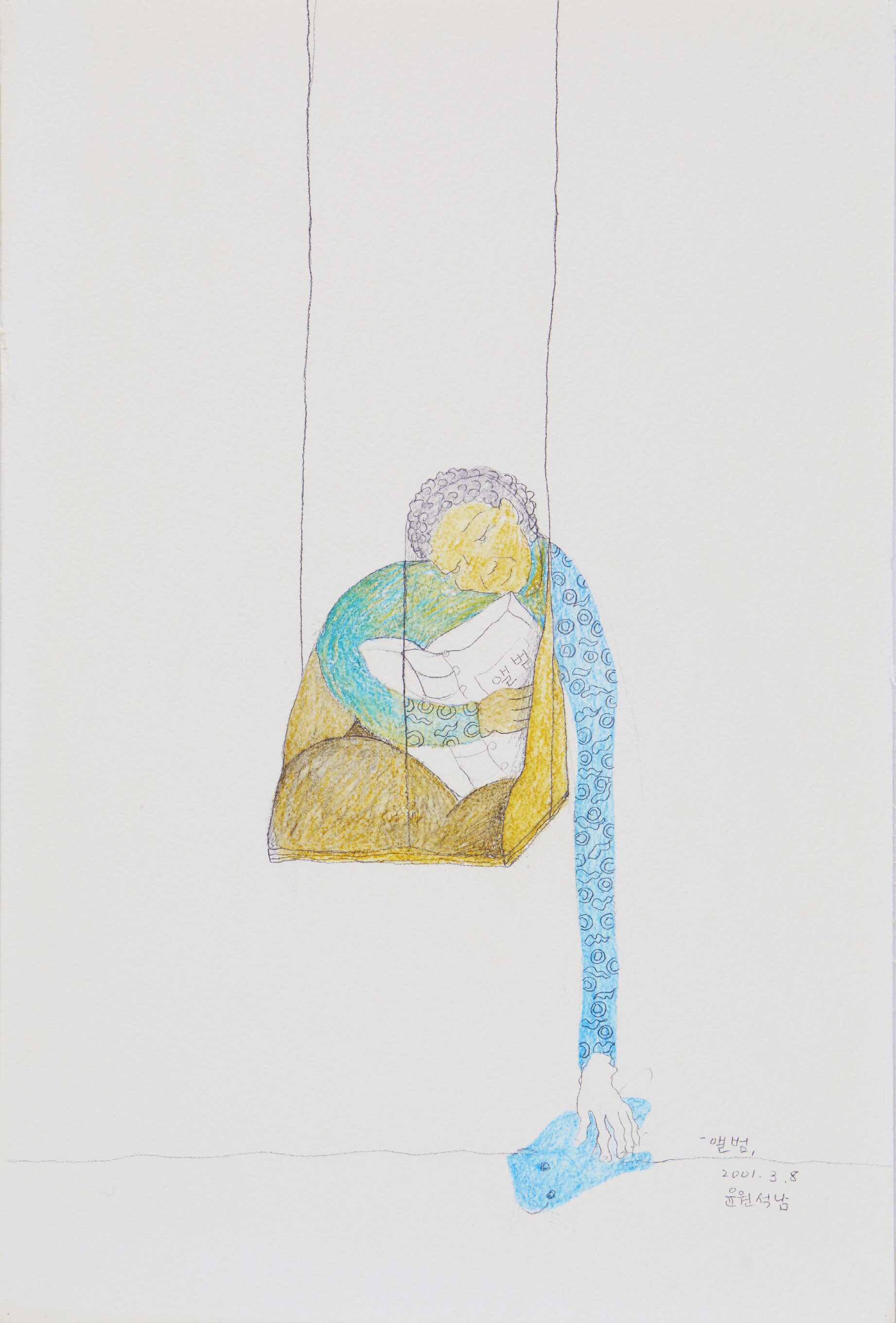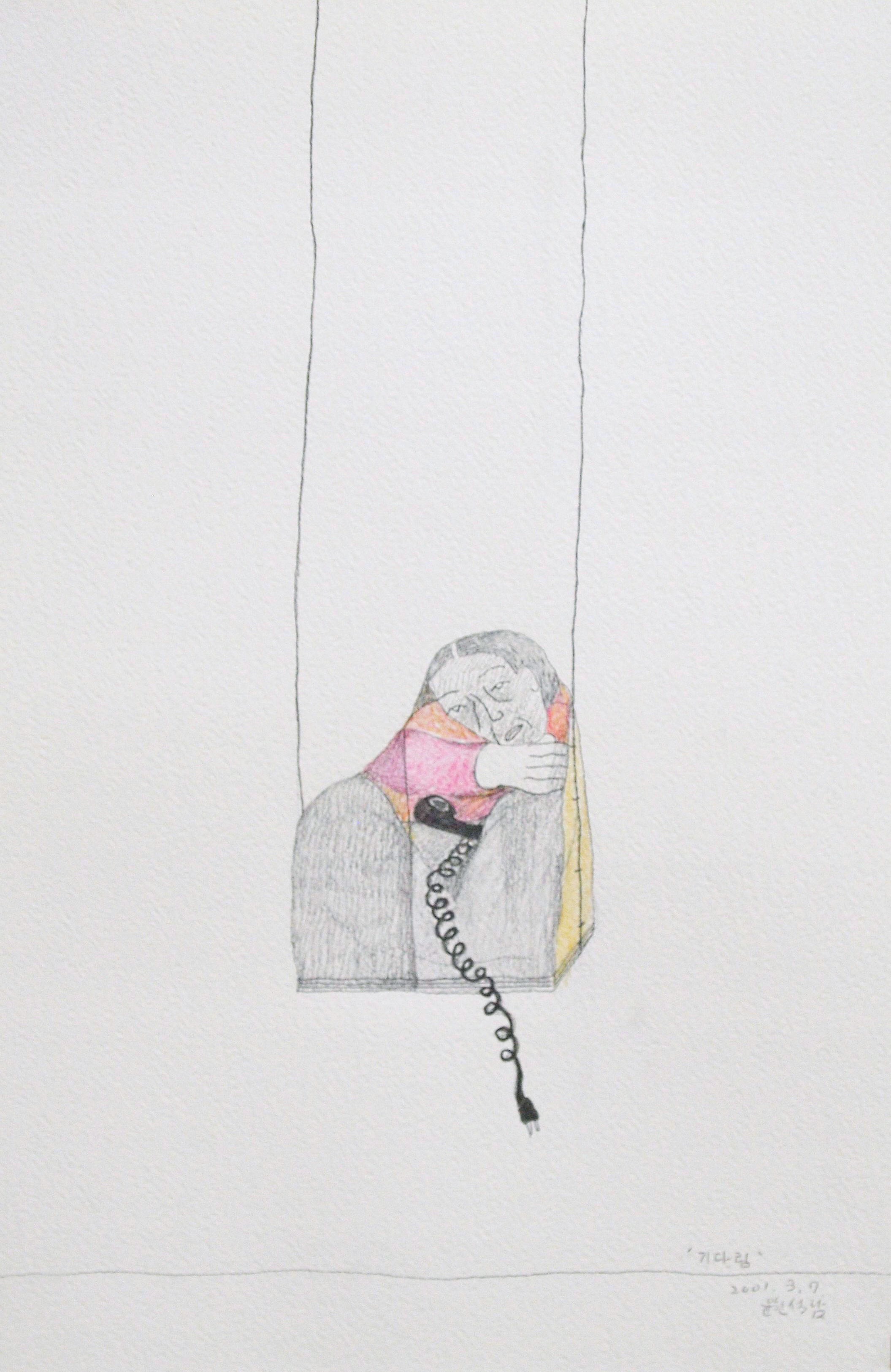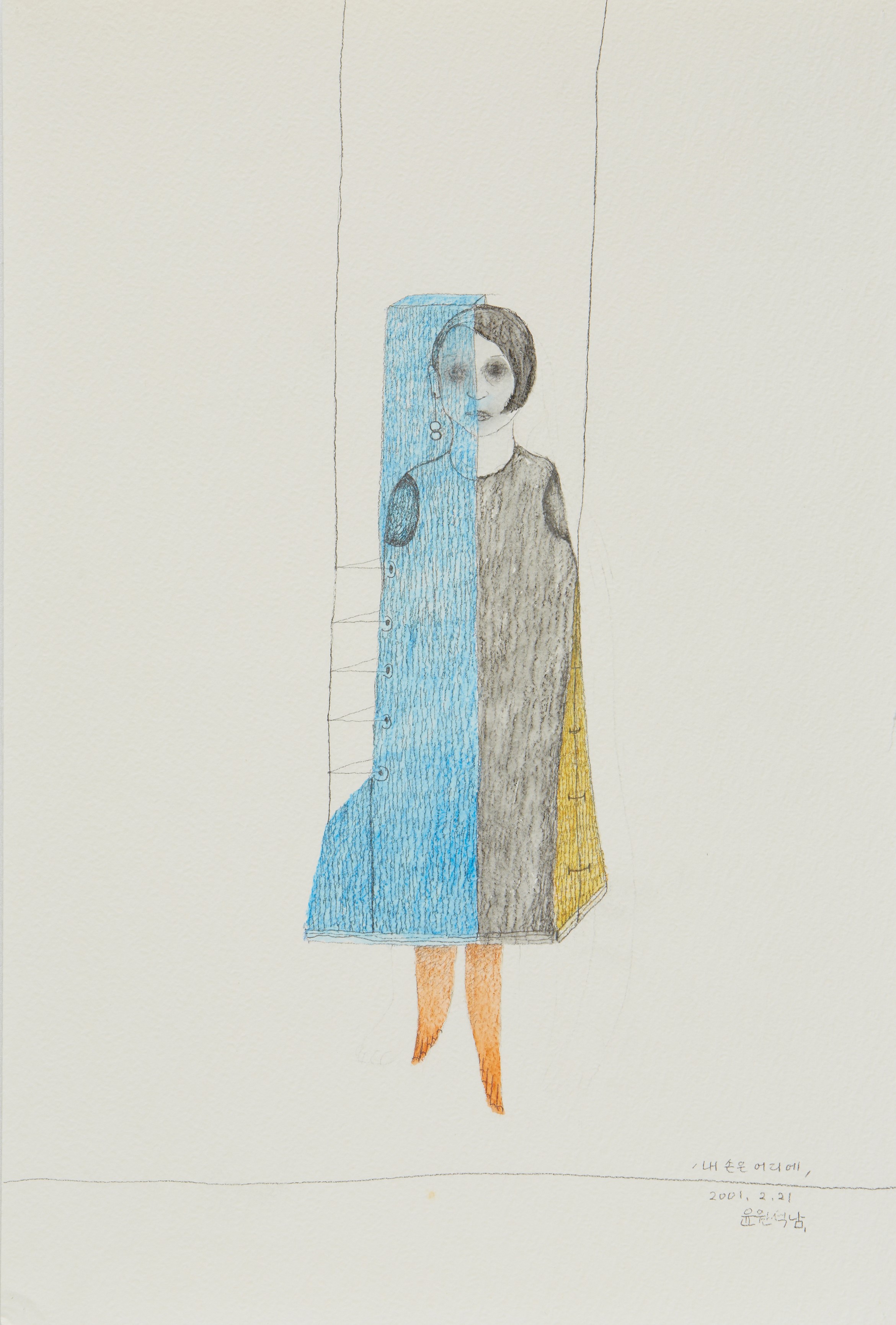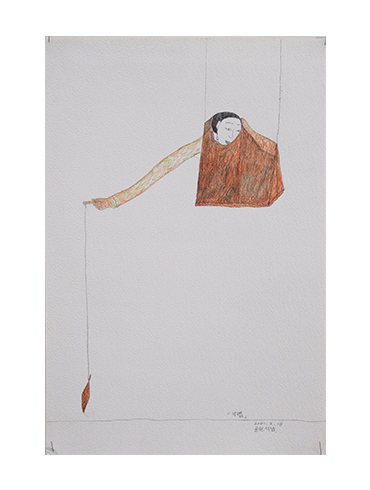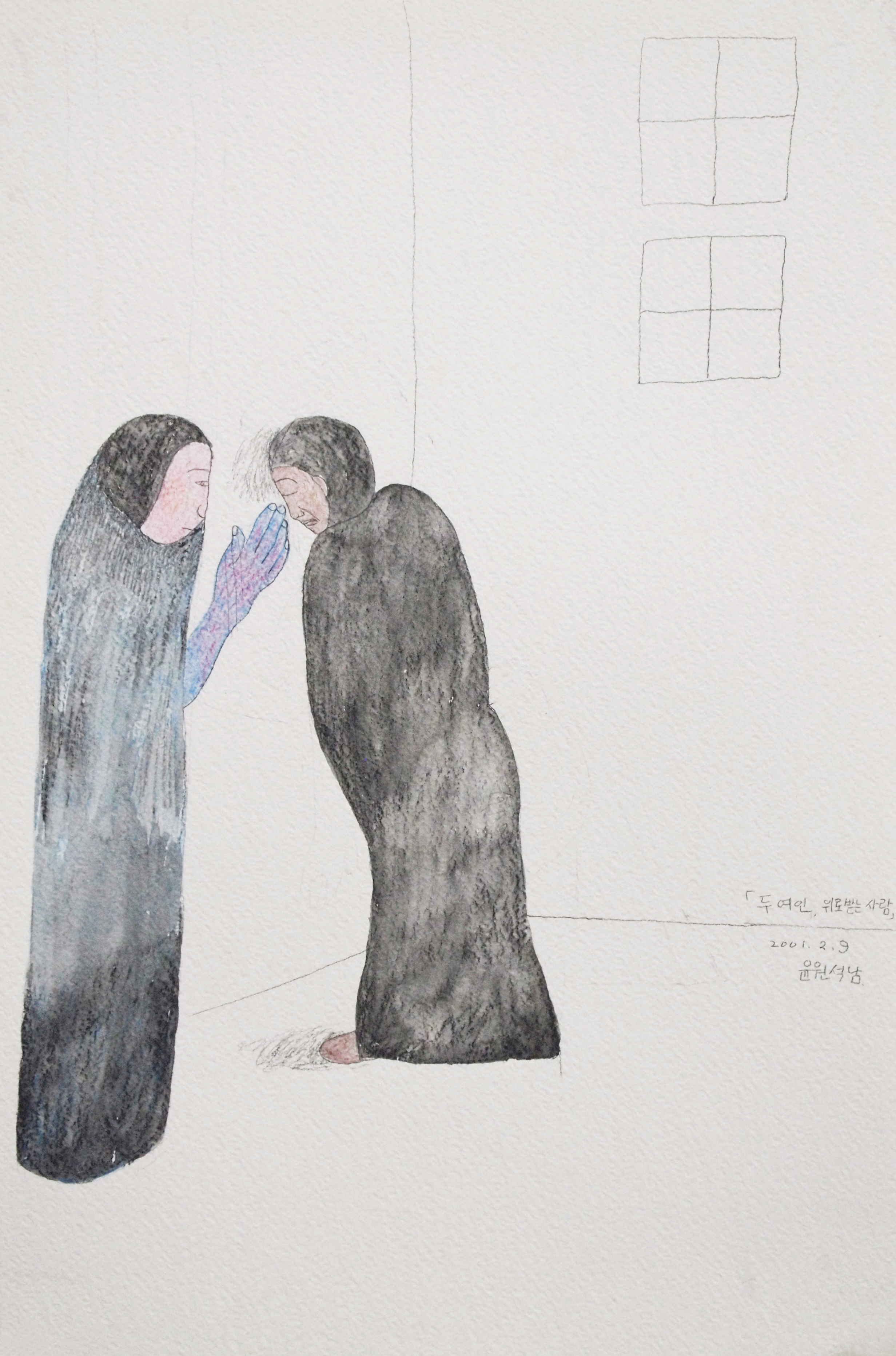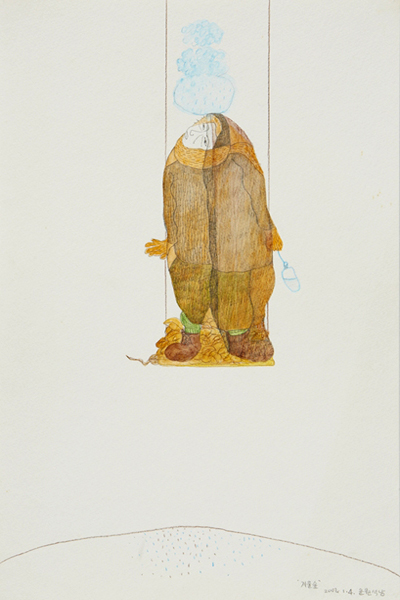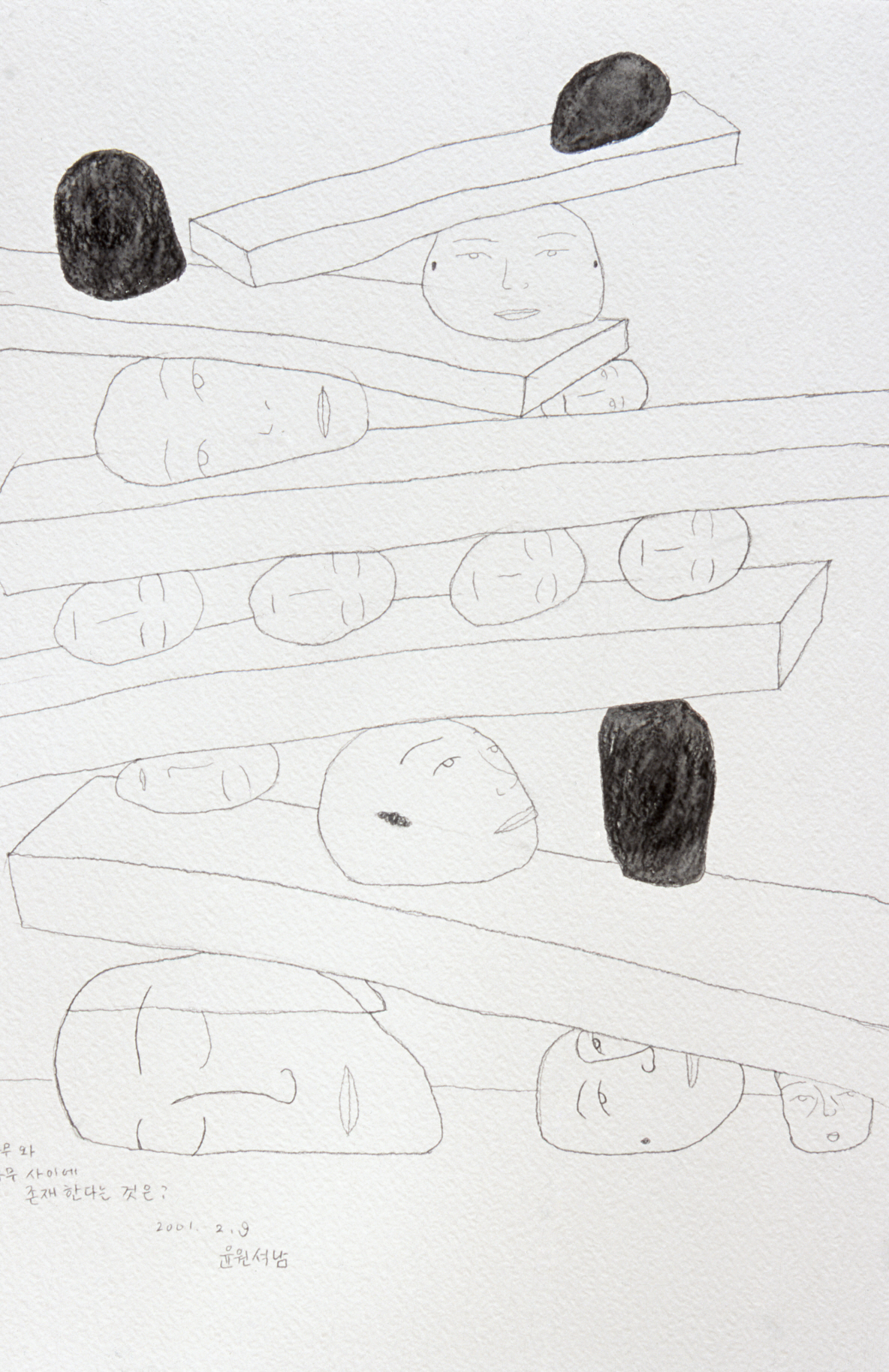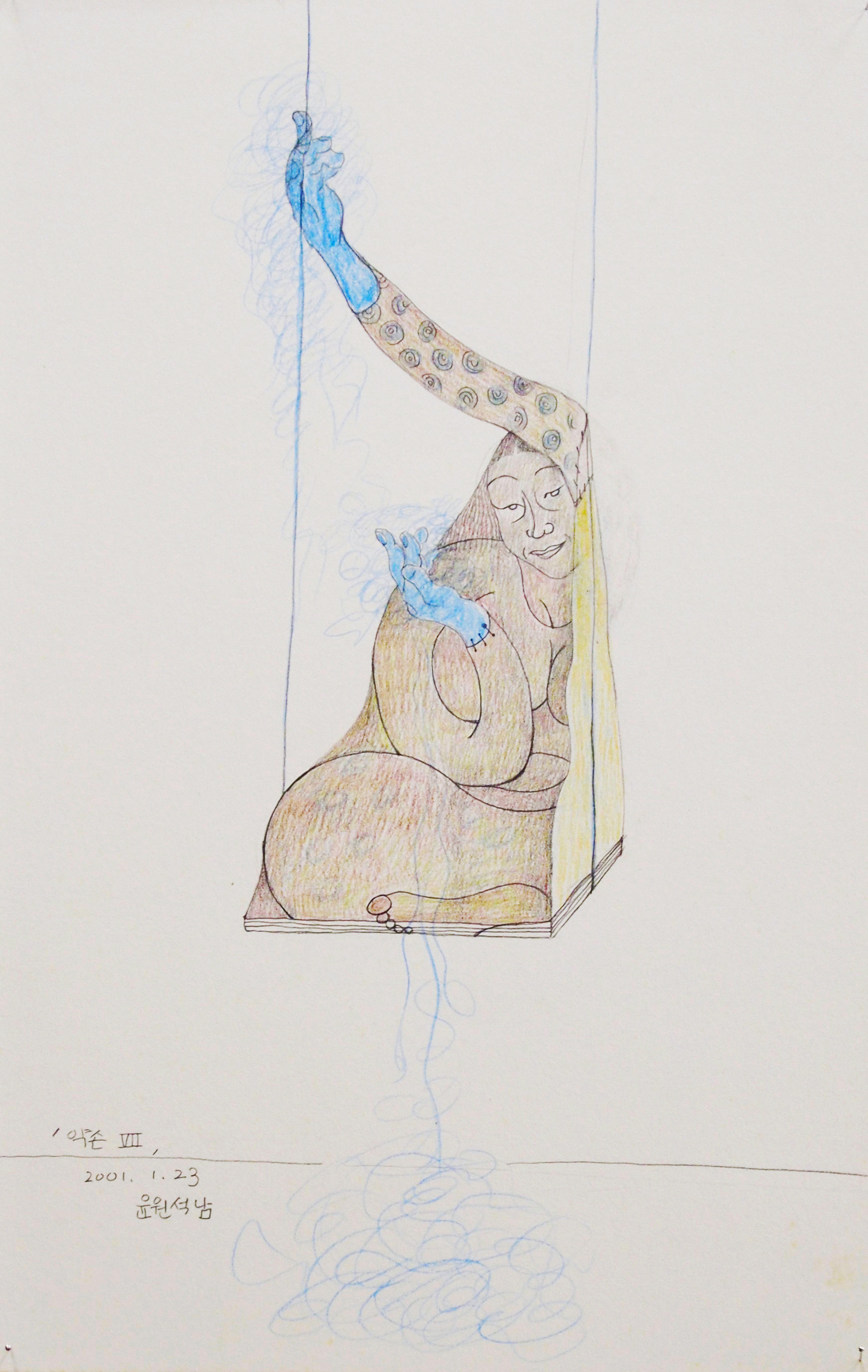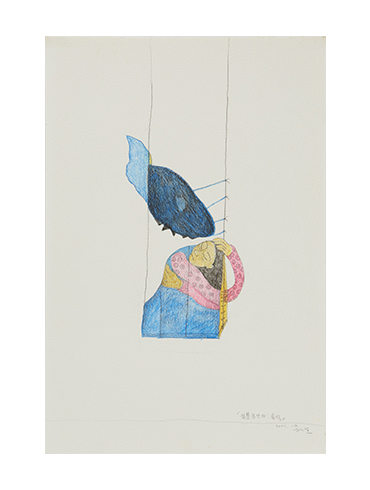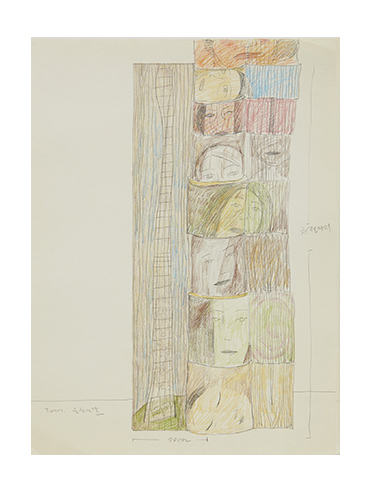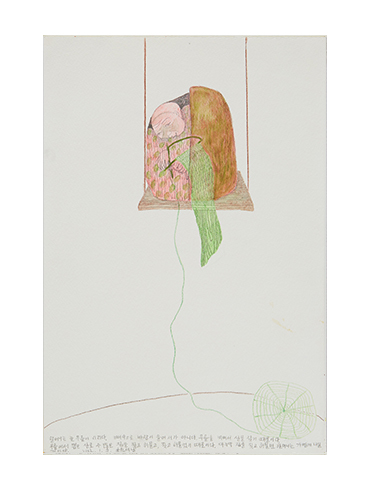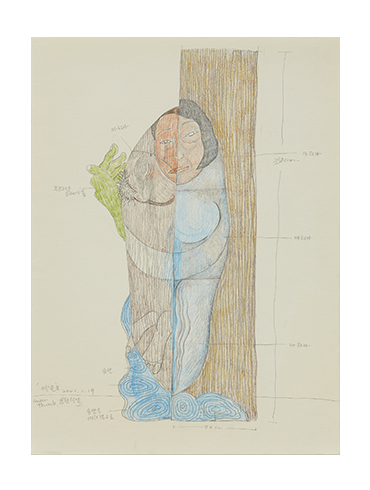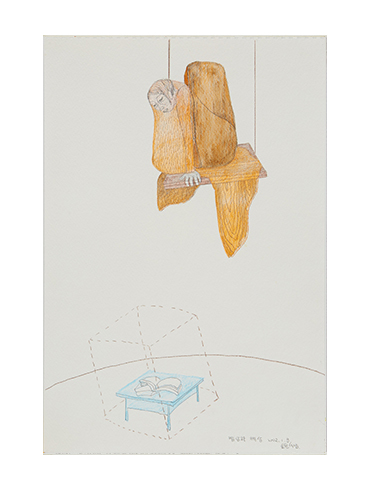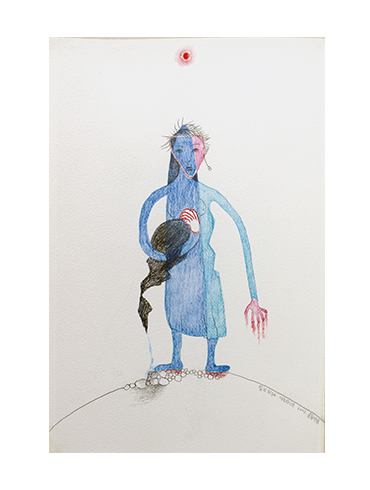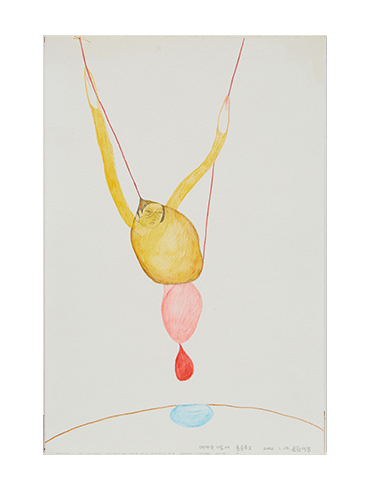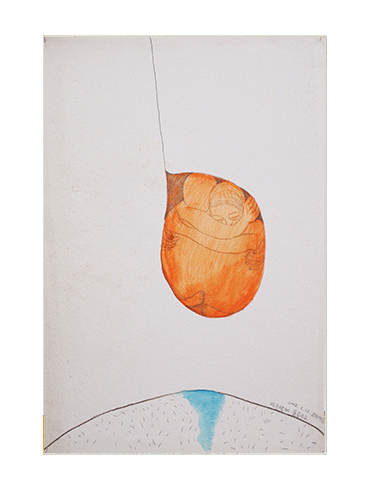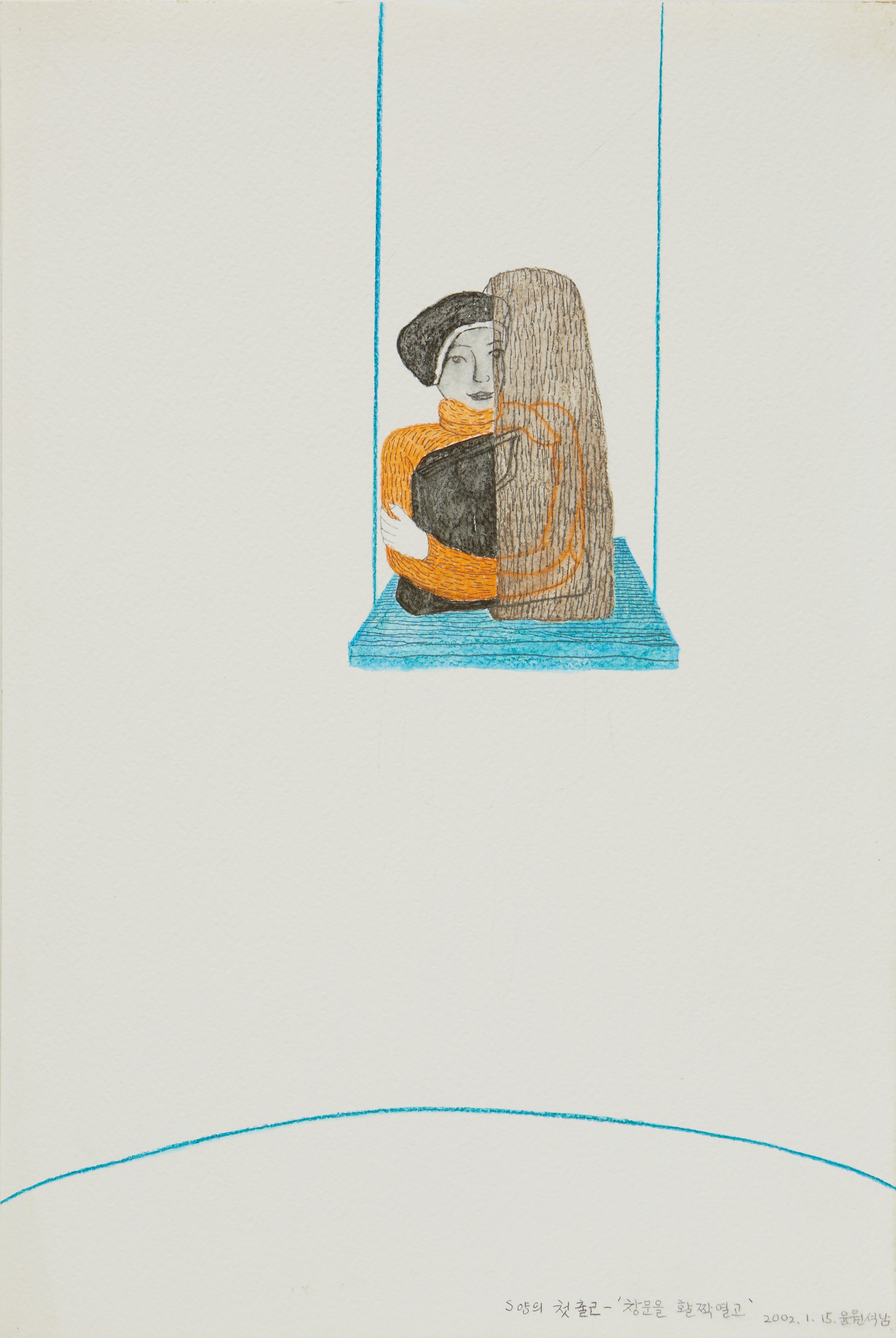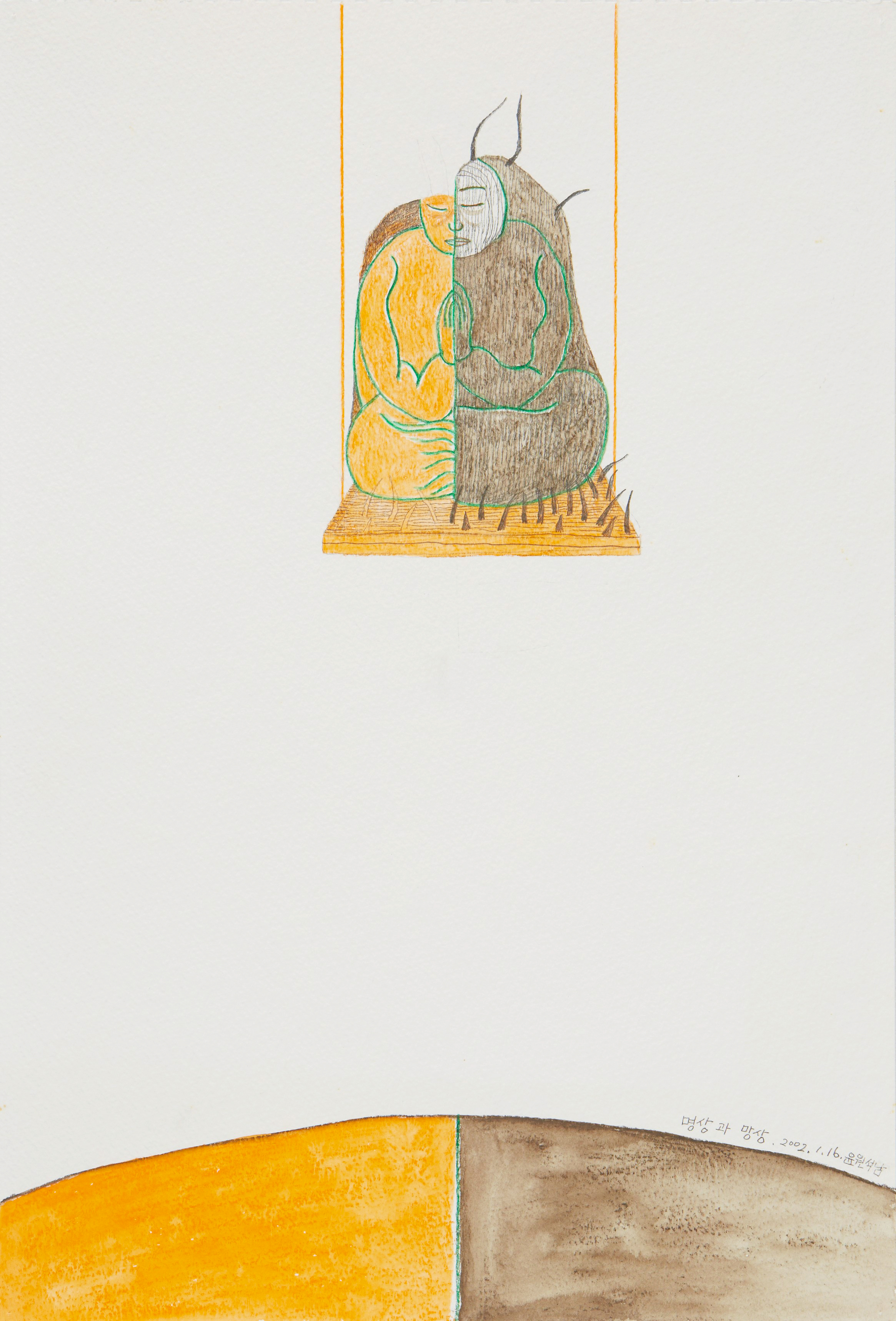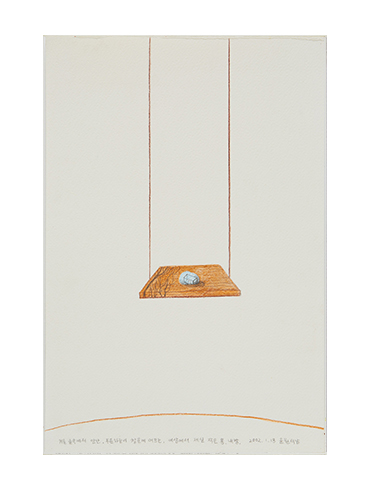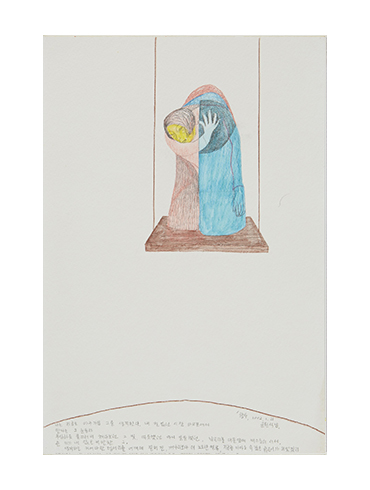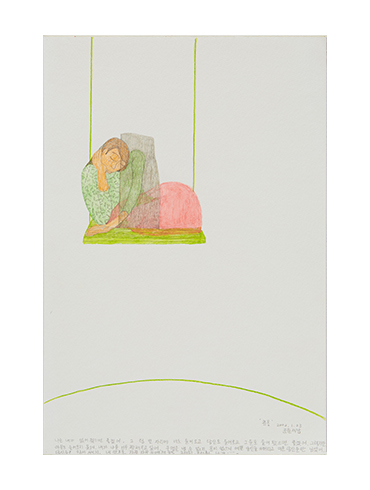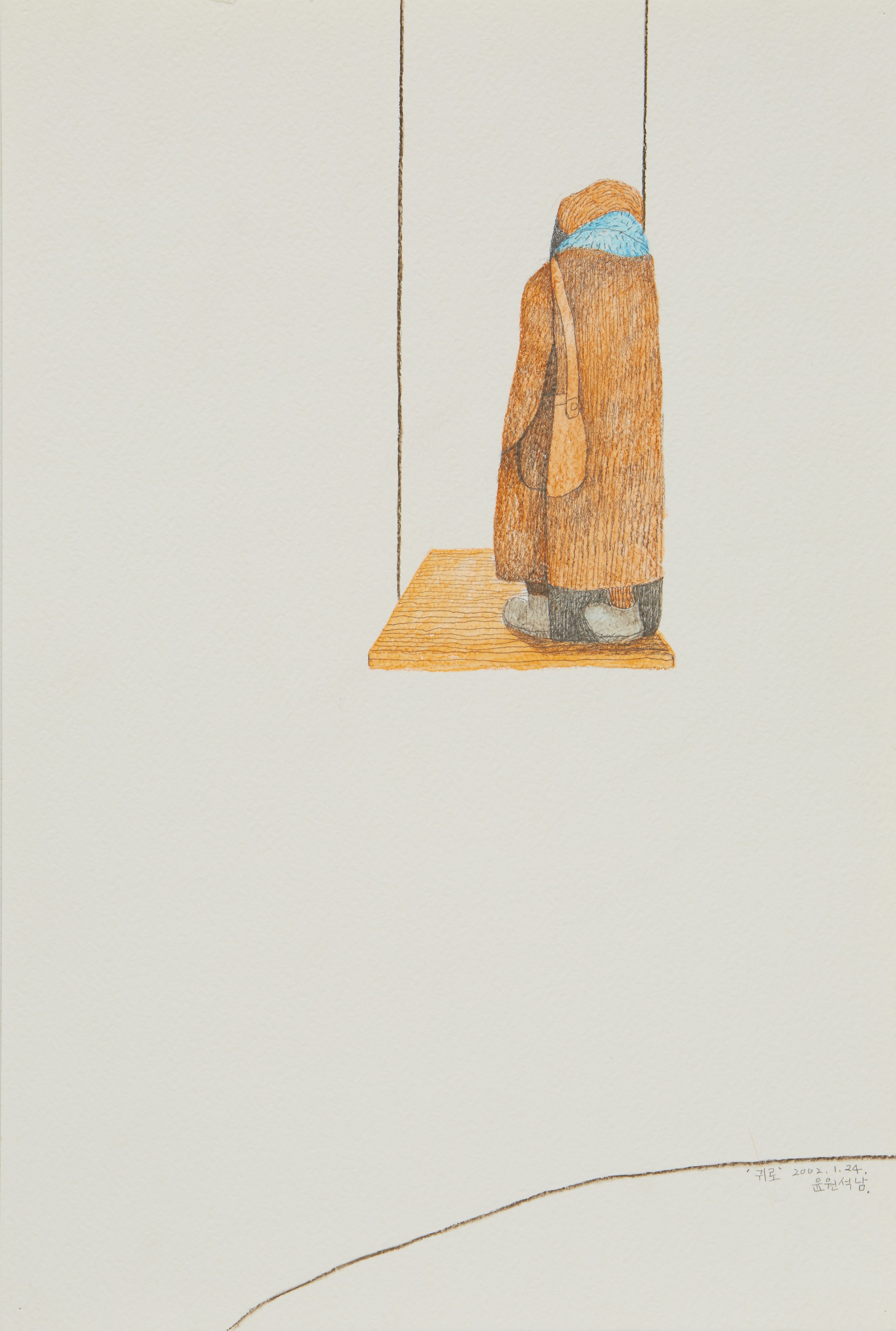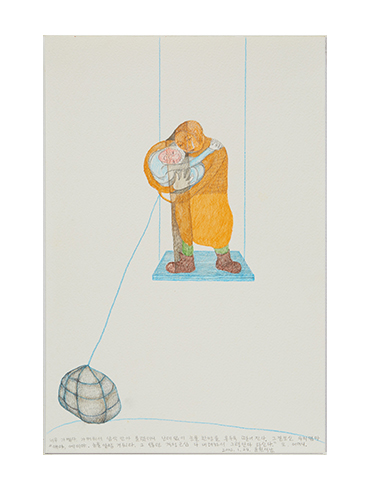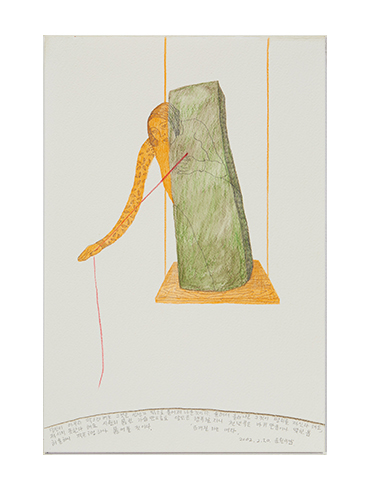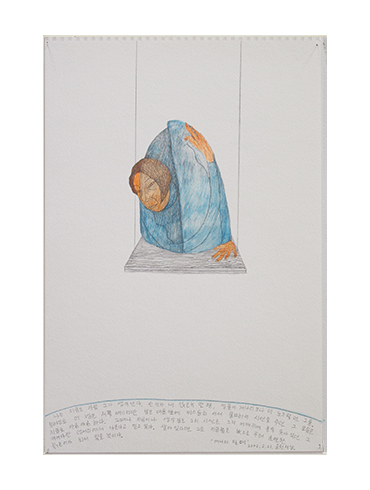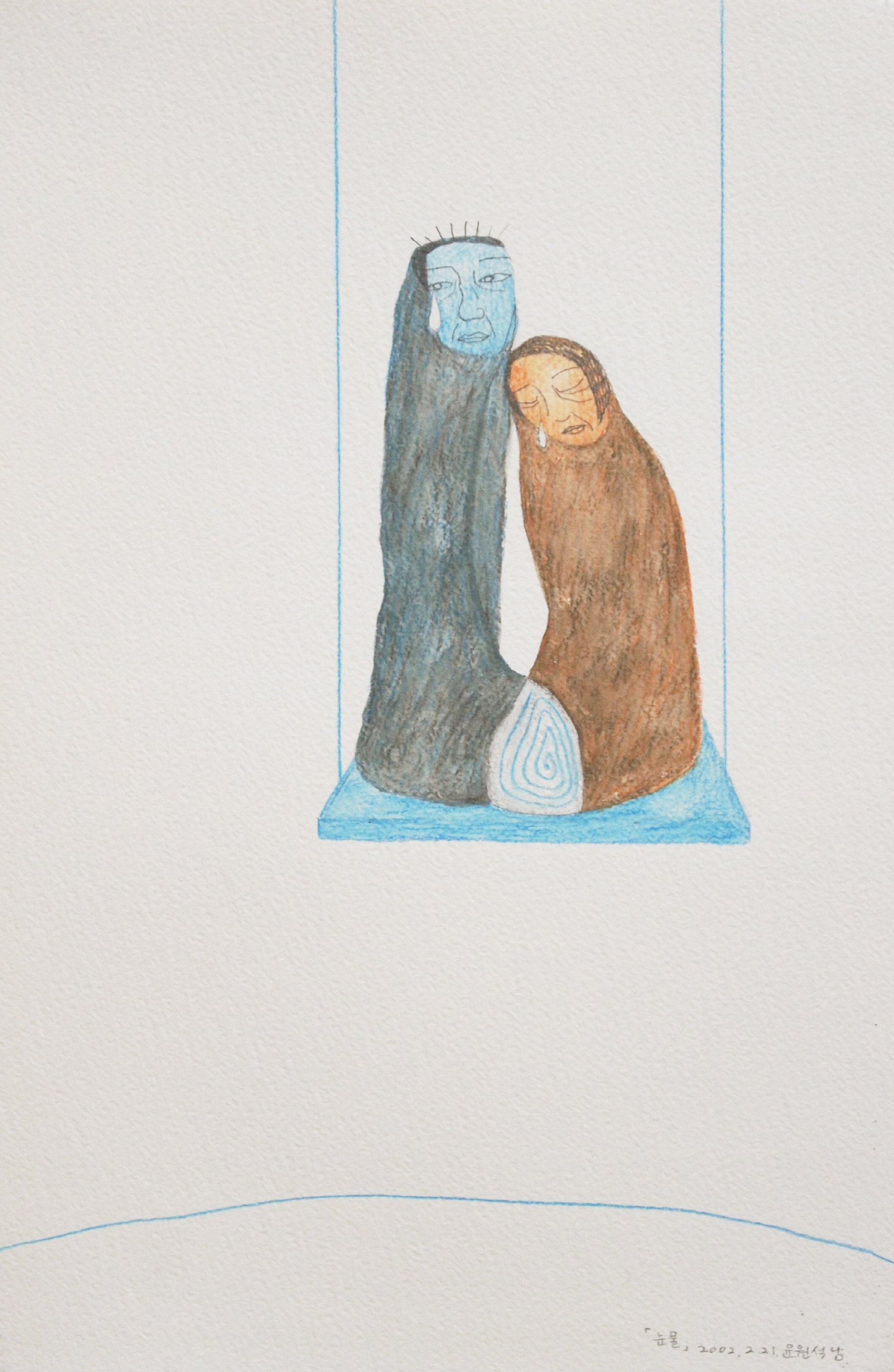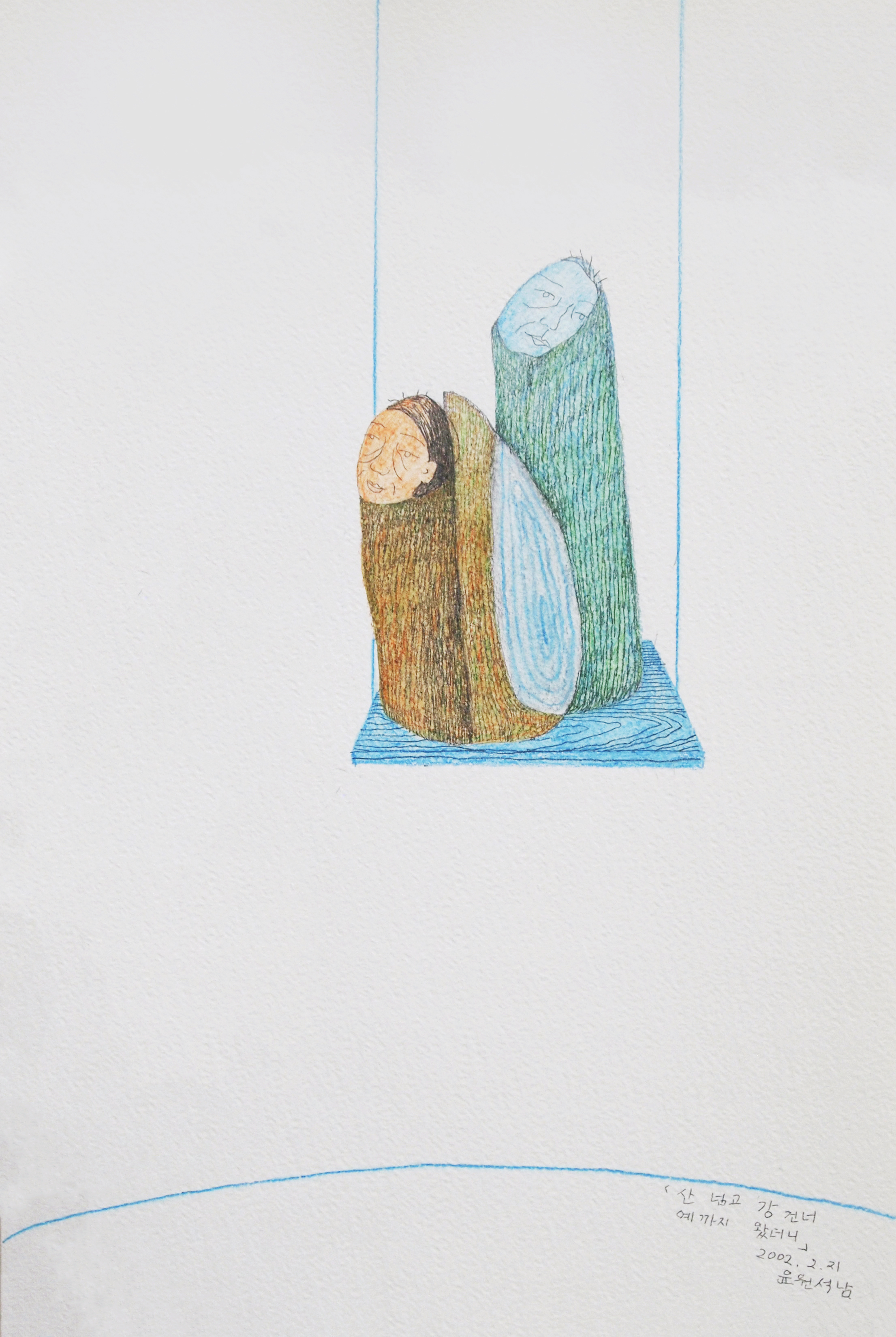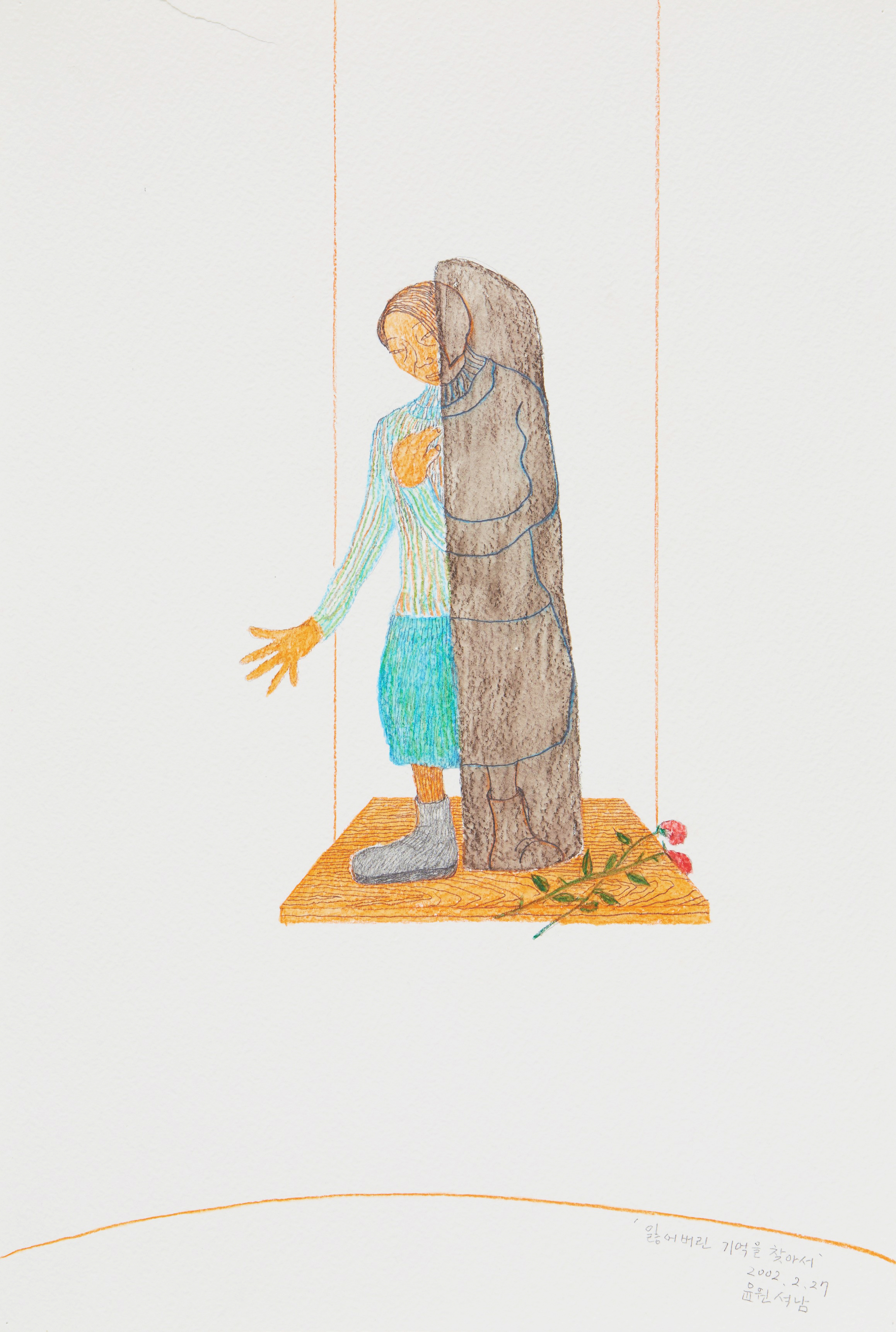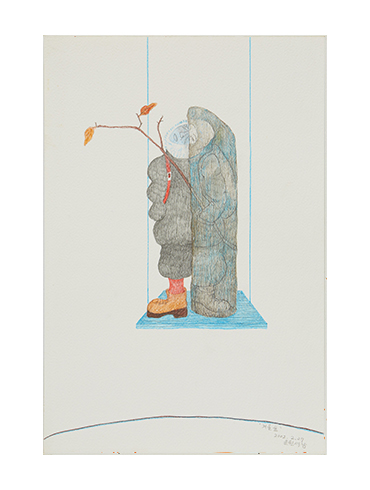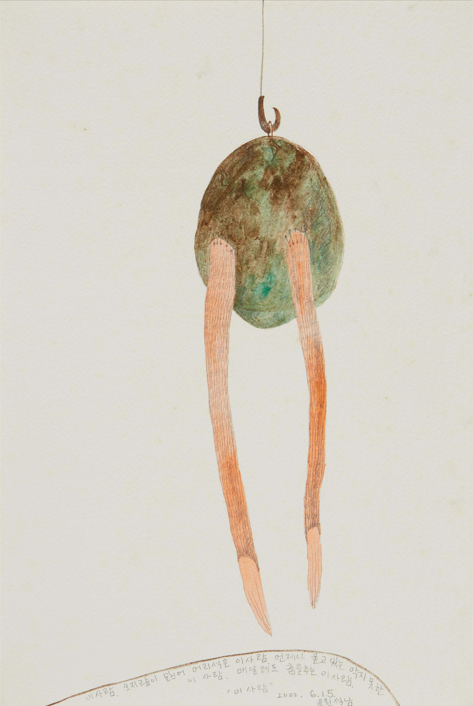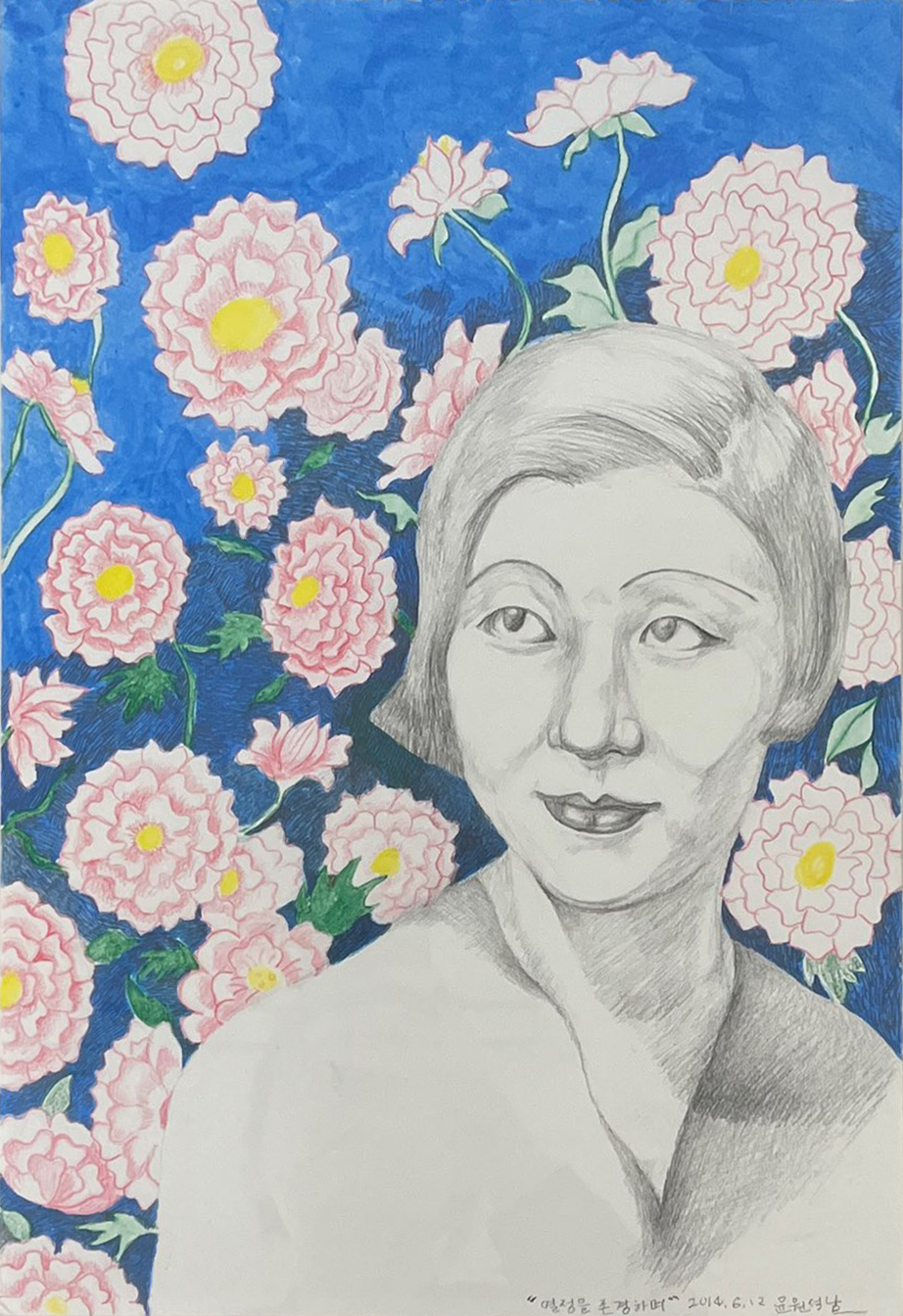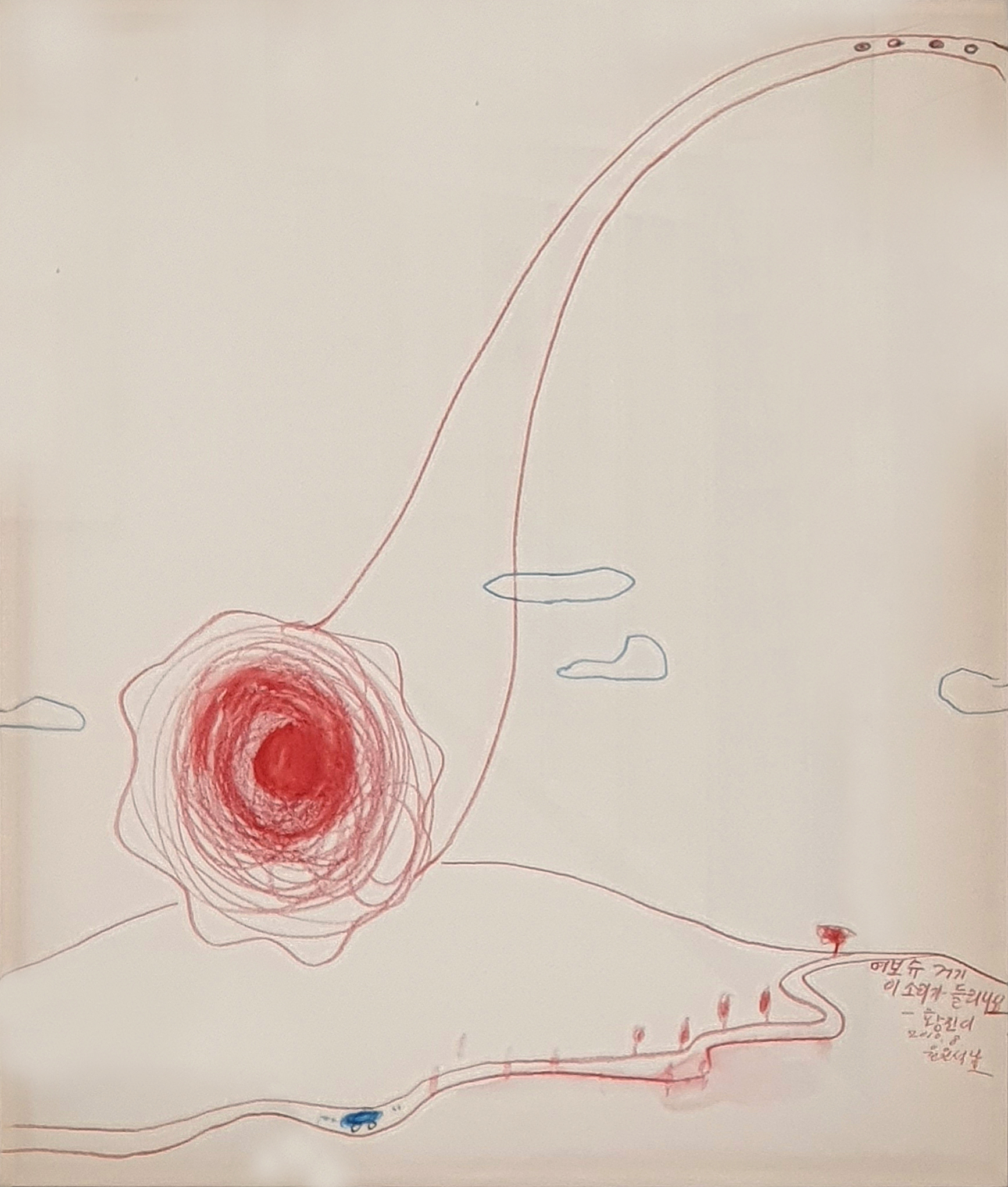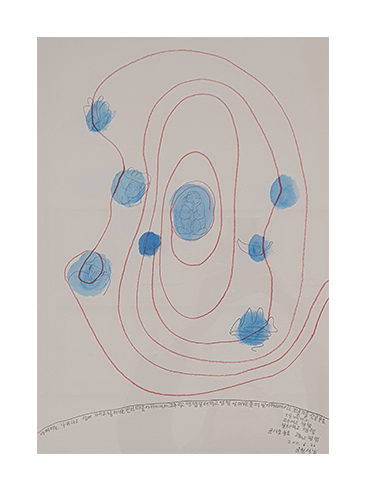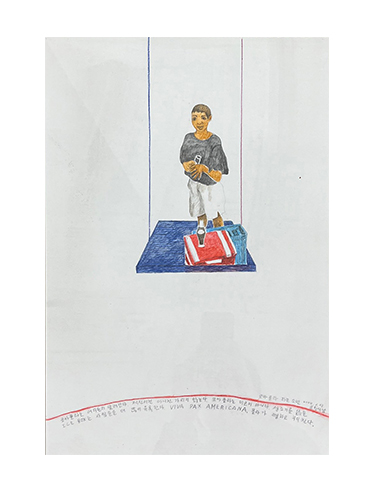Prev
Next
윤석구ᆞ윤석남 2인전: 뉴 라이프
윤석남과 윤석구는 남매지간으로 각자의 예술 작업에 정진해 온 미술가이다. 근대 영화감독이자 소설가, 연출가인 윤백남과 원정숙 부부의 여섯 자녀 중 윤석남(1939-)은 둘째, 윤석구(1947-)는 다섯째로 8살 터울이다. 이 집안에서는 미술, 음악, 영화 등 다양한 예술 분야의 종사자들이 여러 명 배출되었다. 미술가로는 한국 페미니즘 미술의 초석을 다지고 그 길을 꾸준히 개척해 온 선구적 작가 윤석남이 익히 알려져 있고, 남동생 윤석구 역시 평생 미술에 헌신해 온 조각가이다. 서로의 예술을 지지하되 간섭하지 않고 독자적으로 작업해 온 탓인지 두 작가가 남매란 사실은 미술계에서 아는 사람만 아는 정도다.
이번에 학고재가 기획한 윤석남, 윤석구 2인전은 공식적으로 남매가 함께 갖는 첫 전시다. 지금까지 두 작가가 미술로 뭔가를 도모한 사례는 2012년 전북 익산국제돌문화프로젝트의 일환으로 제작한 조각이 유일하다. <휴식>이란 제목의 이 조각은 윤석남이 제안한 개념과 드로잉에 근거해 윤석구가 제작한 협업의 결과물이다. 윤석남 작품의 주요 소재인 소파와 개, 그리고 당시 윤석구의 관심사이던 나무를 상징하는 세 가지 형상을 익산에서 생산되는 화강암의 일종인 황등석으로 깎아 익산 중앙체육공원에 영구 설치한 작품이다.
윤석남은 좋은 전시 기회가 있을 때면 늘 후배 여성작가들과 공유하며 동반 성장을 도모해 왔는데, 본 전시에서는 최근 몇 년간 심혈을 기울여 제작한 남동생 윤석구의 독특한 미발표 작품이 돋보이도록 조용히 뒤로 한걸음 물러나 있다. 평문을 준비하며 나는 평상시 서로의 작업에 관해 별로 이야기를 나누지 않는다는 두 사람을 따로 만나 서로의 작업에 관한 생각을 물어보았다. 윤석남은 조용한 성격의 동생이 원광대학교에서 교육과 작업을 병행하느라 바삐 사는 것이 안타까웠는데, 은퇴 후 새로운 작업을 찾아 도약하는 모습에 안도하며 아낌없는 격려를 보내고 있음을 느낄 수 있었다. 한편 윤석구는 “누님의 조각과 회화적인 것을 결합한 나무 작업에서 큰 감명을 받았다”고 회고했다.[1] 덧붙여 말하길 그림을 그리다 나무를 조각해 그 위에 형상을 그린 작업 방식은 획기적이고, 매체의 경계를 중요시하는 미술대학에서는 배울 수 없는 전통 파괴의 가능성을 지녔다며 윤석남의 작품에 큰 의미를 부여했다.
이번 전시에는 윤석남이 2000-2003년 사이에 그린 700여 점의 드로잉 중 선별한 96점과 윤석구의 미발표 신작 15여 점이 출품된다. 1990년대 초부터 나무를 다듬어 그 위에 여성 인물을 그린 조각과 레디메이드를 활용한 설치 작품에 몰입해 오던 윤석남은 2000년대 초 작업에 대한 고민을 풀어내거나 ‘그리기’에 대한 욕구를 해소하기 위해 일정한 크기의 종이에 색연필과 연필을 이용해 수많은 드로잉을 남겼다. 2015년의 개인전 《윤석남♥심장》(서울시립미술관)에서 독립적인 작품으로 처음 소개된 드로잉은 다수의 전시에 출품되며 예술성을 인정받고 있다.
윤석남의 드로잉 작품은 완성작을 위한 밑그림이나 습작이 아니라 여성주의적 성찰과 꾸준한 독서를 통해 축적된 문학성이 배어나는 글과 그림의 예술적 조합으로 이뤄진다. 팔십 중반의 윤석남에게 책 읽기는 여전히 그림 그리기와 더불어 몸에 익은 습관처럼 빼놓지 않고 행하는 하루의 일과다. 여러 단계의 복잡한 제작 과정과 함축적 서사를 담은 입체 작업과 비교해, 자발적으로 떠오르는 이야기나 형상을 단시간에 즉흥적으로 그리고 글귀를 써넣은 그의 드로잉은 세로 형식의 그림일기를 연상시킨다. 그것은 여성으로서 자전적 경험과 생각들, 친밀한 인간관계에 대한 단상들, 문학에서 떠오른 영감 등 시간과 공간이 자유롭게 교차하며 자발적으로 흘러나온 시적 성격이 강하다. 그러므로 유머와 재치가 넘치고 공감과 상상력을 자극하면서도 직관적인 독해가 가능한 윤석남의 간결한 드로잉은 묵직한 현실 문제도 거부감 없이 받아들이도록 하는 독특한 성격을 띤다.
제도 교육의 틀 밖에서 전업 작가의 길을 걸어온 윤석남과 달리, 윤석구는 엘리트 미술 교육 과정을 차근차근 밟으며 누나에 앞서 1978년 첫 개인전을 열고 조각가로서 화단에 등단했다. 서울에서 태어나고 자란 그는 홍익대학교의 김정숙 교수 밑에서 조각을 전공한 후 독일 유학을 다녀왔고, 1980년대까지 3차례의 개인전을 통해 실존적 상황에 직면한 고통받는 인체 조각을 발표해 주목받았다. 그는 1987년부터 원광대학교에서 26년간 교직에 종사하며 작업을 병행해 오다, 2013년 퇴직 후 경기도에 정착해 온전히 작업에 시간을 쏟았다. 그런 모습을 눈여겨보던 윤석남이 2018년 화성 작업실의 한 공간을 동생에게 내어주며 이곳은 둘의 창작의 산실이 되었다.
윤석구의 신작(新作)을 설명하는 키워드로는 ‘천 작업’, ‘천 싸기’, ‘개작’, ‘레디메이드’를 꼽을 수 있는데, 그중 핵심 키워드는 ‘천 작업’ 또는 ‘천 싸기’이다. 그는 최근 몇 년 동안 ‘천 조각 콜라주’와 ‘천으로 싸기’라는 두 가지 방법으로 새로운 작품을 제작하고 있다. 그가 조각에 천의 모티브를 처음 도입한 것은 15년 전으로 거슬러 올라간다. 대학 재직 시 작업실 근처에서 숲을 벌목하며 쓸모없는 나무를 버리는 현장을 목격한 뒤, 쓸모에 따라 버려지는 생명을 보듬고 상처를 치유하기 위한 상징적 의식으로서 나무를 천으로 싸는 예술적 행위를 시작했다고 한다. 그 후 골판지로 인물 형상을 만들고 천을 붙이는 작업으로 발전했고, 2019년 남성)>을 기점으로 새로운 전환점을 맞았다. 본 전시에 출품된 모든 작품에는 대상을 지시하는 부제와 더불어 “A New Life”라는 제목이 주어지고, 전시 제목도 동일하다. “새로운 삶”, “재탄생” 등으로 번역 가능한 “A New Life”는 윤석구 최근작의 주제이자 작업 개념, 작업 방법 전반을 아우르는 용어이다. 작가가 생각하는 “A New Life”의 의도는 다음과 같이 정리할 수 있다. 다양한 색과 무늬를 지닌 천의 시각적 특성을 살려서 상처를 품고 있는 버려진 대상들을 천으로 감싸줌으로써 새로운 생명으로 재탄생시키는 의식을 행하고자 했다. 그런 작품을 통해 그는 궁극적으로 물질만능주의 시대를 살아가는 우리에게 무엇이 옳은지에 대한 물음을 던지고자 했다.[2]
그의 신작에서 작업의 대상은 두 가지 계열로 나뉘는데, 작가의 기존 작품을 ‘개작’한 것과 주변에서 쓰다 버린 레디메이드를 재활용한 것이다. 윤석구가 본인의 기존 작품에 각종 천을 붙여 원작의 외양과 의미를 소거하고 새로운 작품으로 탈바꿈시키는 과감한 아이디어는 매우 흥미를 자아낸다. 그는 1970-80년대에 새로운 조각용 재료로 각광받던 합성수지(FRP)를 위주로 나무, 테라코타 등의 재료를 사용해 실존적 상황에 놓인 인간의 고뇌와 고통을 거칠고 왜곡된 대형 인체로 제작한 바 있다. 생명공학의 발전이 가져올 유토피아적 미래에 대한 비전과 비판이 충돌하고 유전자 조작이 사회적 이슈로 대두된 1990년대 중반에는, 합성수지로 매끈하게 주조한 대형 과일과 채소에 인공적인 색을 칠해 자연의 변종과 신품종 개량에 대한 경종을 울리고 물질적 욕망을 추동하는 자본주의를 비판하기도 했다.
개작한 작품으로는 사과 2)>(2019), 과일들)>(2020), 바나나)>(2021), 빌렌도르프의 비너스)>(2022) 등 다수가 있다. 일례로 인간 1)>과 인간 2)>(2020)는 1987년에 제작한 <人間(인간)의 굴레 I, II>를 개작한 것이다. 레오나르도 다빈치의 <비트루비안 맨>을 참조한 1987년의 원작은 세계의 척도로서 인체를 과학적으로 탐구한 다빈치의 개념 대신, 원형의 굴레에 갇혀 벗어날 수 없는 인간의 보편적 상황을 남자의 앞뒤 인체 조각을 통해 은유적으로 재현했다. 윤석구는 그 남자 조각의 뒷면을 각종 패턴이 찍힌 푸른 계열의 천 조각으로, 앞면을 붉은 계열의 천 조각으로 이어 붙여 원작에 내재한 비장함을 제거하고 마치 자웅동체의 인물상처럼 조형적으로 탈바꿈시켰다. 사과 2)>(2019)는 1998년에 발표한 <신종(新種)> 연작의 대형 사과 조각을 개작한 것이다. 매끈하게 자른 사과의 흰 단면은 꽃무늬 또는 동심원의 추상적 패턴의 알록달록한 천 조각으로 뒤덮이고 사과 껍질 부분과 커다란 두 개의 씨는 심장처럼 붉은 천으로 싸여있다. 오이, 가지, 감자 등 대형 야채는 그와 유사한 색의 단일한 천으로 싸여있다. 개작한 작품들은 원작의 기본 형태나 자세가 그대로 유지되기 때문에 그 흔적을 완전히 지울 수는 없다. 그러나 덧붙인 천 작업으로 인해 원작에 부여된 본래의 의미는 탈각되고 팝적인 유희성과 조형미가 강화된다.
아파트 단지에서 내다 버린 폐기물이나 쓸모없이 방치된 레디메이드를 재활용해 천으로 감싼 작업의 대상은 가구(의자, 테이블, 소파), 어린이 놀이 기구(자전거, 자동차), 예술적 기물(미술 교육용 석고상, 이젤) 등이다. 이런 계열의 작품 대부분은 그 대상과 분위기에 어울리는 적절한 색과 문양을 가진 천으로 싸여있다. 어린이용 자전거와 자동차는 동그랗고 화려한 문양의 형광색 천으로 감싸서 어린 아이의 발랄하고 역동적인 움직임과 팝적 유희와 연결된다. 화해)>에서는 인간의 대립과 화해의 기조를 흑백의 의자와 두 가지 색이 조화를 이룬 테이블로 시각화하였다. 한편 거울)>는 천으로 싼 이젤과 그 위에 세워진 테두리만 남은 거울, 두 손으로 얼굴을 가린 채 거울 안에 갇힌 듯한 인물 조각의 형상이 이질적이고 그로테스크한 감각을 유발한다. 특히 이 작품은 인체 조각의 일부를 그대로 남겨둠으로써 미술에서 사라지지 않는 순수미술과 공예의 위계적 관계를 환기하기에 더욱 시선을 끈다.
사실 천으로 싸는 윤석구의 작업 방식이 독창적인 것은 아니다. 동시대 미술에서 천을 사용한 예술은 비일비재하다. 천을 이용한 동시대의 예술은 순수미술과 수공예를 구별하고 순수미술에 최고의 가치를 부여해 온 미술의 전통에 도전했던 1970년대의 페미니즘 미술과 P & D(Pattern & Decoration) 운동의 역사에서 시작되었으므로, 그런 역사에 빚을 지고 있다. 특히 천 작업처럼 장식미술에 낮은 지위를 부여했던 입장에 내재한 성차별주의적 편견을 처음으로 공론화하고 직물 무늬를 창작의 핵심적 요소로 적극적으로 끌어들여 예술 장르 간의 위계를 전복하고자 했던 페미니스트 작가들이 그 변화의 구심점 역할을 했다. 아직도 순수미술과 수공예의 위계적 관계가 완전히 사라지진 않았지만, 천 작업은 페미니스트를 위시한 수많은 예술가에 의해 동시대 미술의 중요한 창작 방법으로 자리 잡았다. 윤석구의 천 작업은 바로 이런 맥락 속에 자리한다. 그의 작품은 다양한 색과 문양을 갖는 천의 시각적 특징을 적극적으로 활용하기에 미학적이고, 동시에 물질만능주의를 비판하고 성찰하는 사회적인 메시지를 명확하게 갖추고 있기에 단순히 장식적인 오브제가 아니라 의미 있는 예술작품이 된다
윤석남은 평등 사회 구현이라는 여성주의적 비전을 바탕으로 여성사를 발굴하고 여성에게 목소리를 되찾아주는 작업을 추구해 왔고, 윤석구는 물질만능주의 시대에 옳은 것이 무엇인가에 대한 보편적인 질문에 답을 찾고자 했다. 두 작가가 거쳐온 예술적 경로와 작품의 지향점은 비록 다르지만, 자본주의를 성찰하고 인간과 자연을 보듬고 살피는 태도는 남매가 매우 흡사하다는 생각이 든다. 윤석남과 윤석구가 반평생 동안 일궈온 예술의 성격을 하나의 단어로 규명해야 한다면 누군가를, 혹은 무엇인가를 “살리는” 예술이라고 부르길 제안한다.
[1] 2024년 2월 20일 경기도 화성 소재 윤석남, 윤석구 작업실에서 인터뷰.
[2] 2024년 2월 초에 작성한 윤석구 작가 노트 참조.





